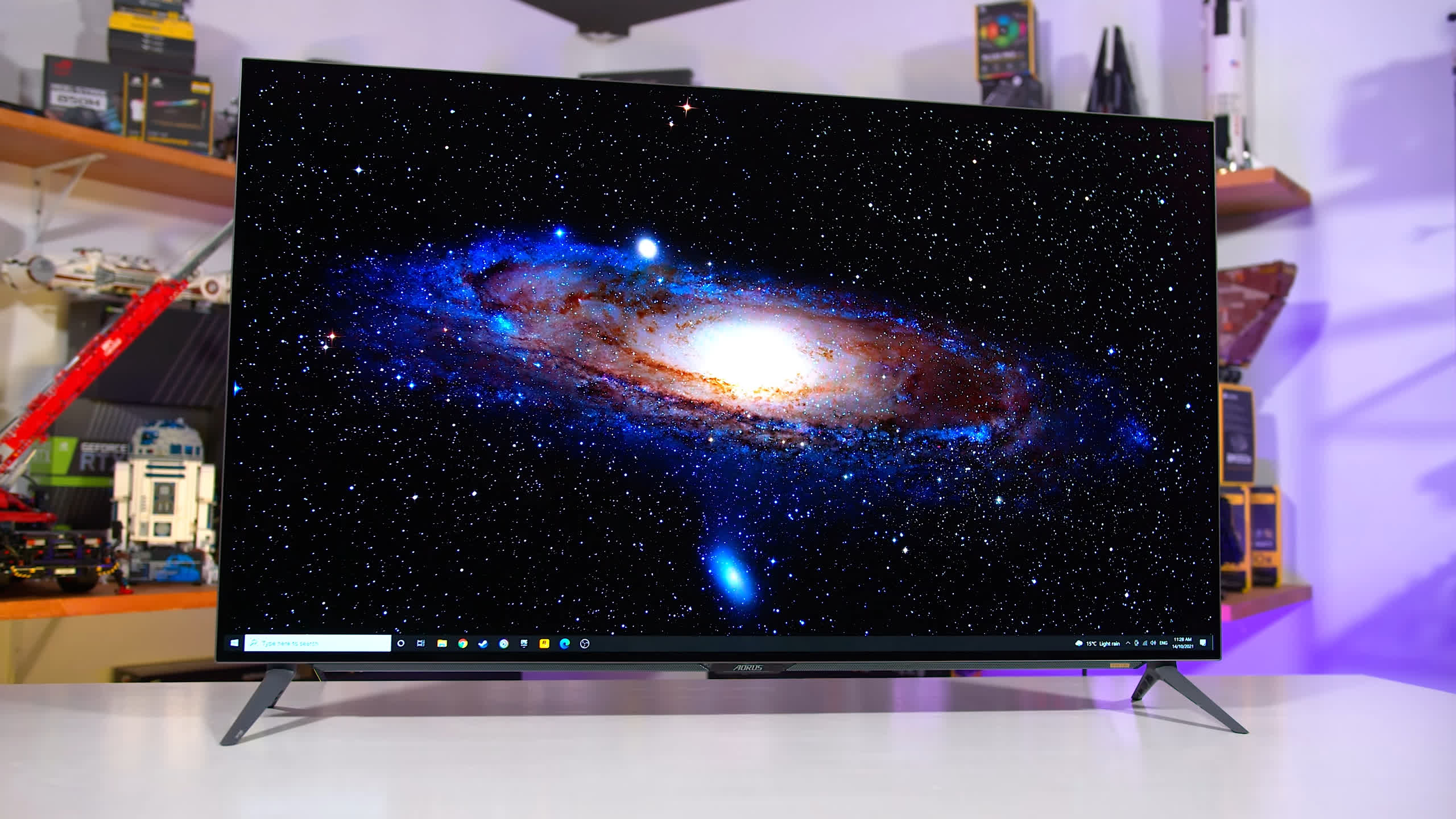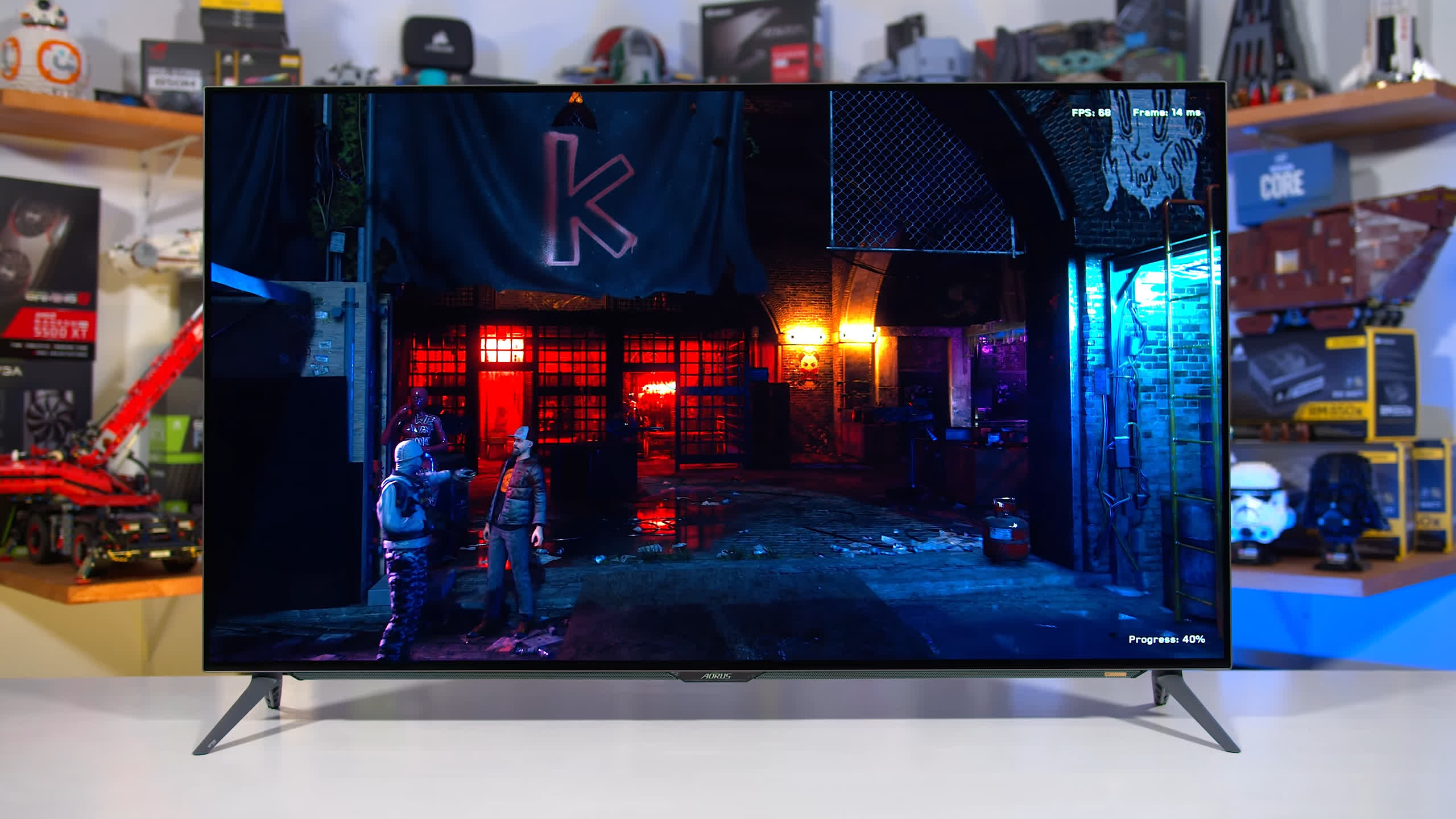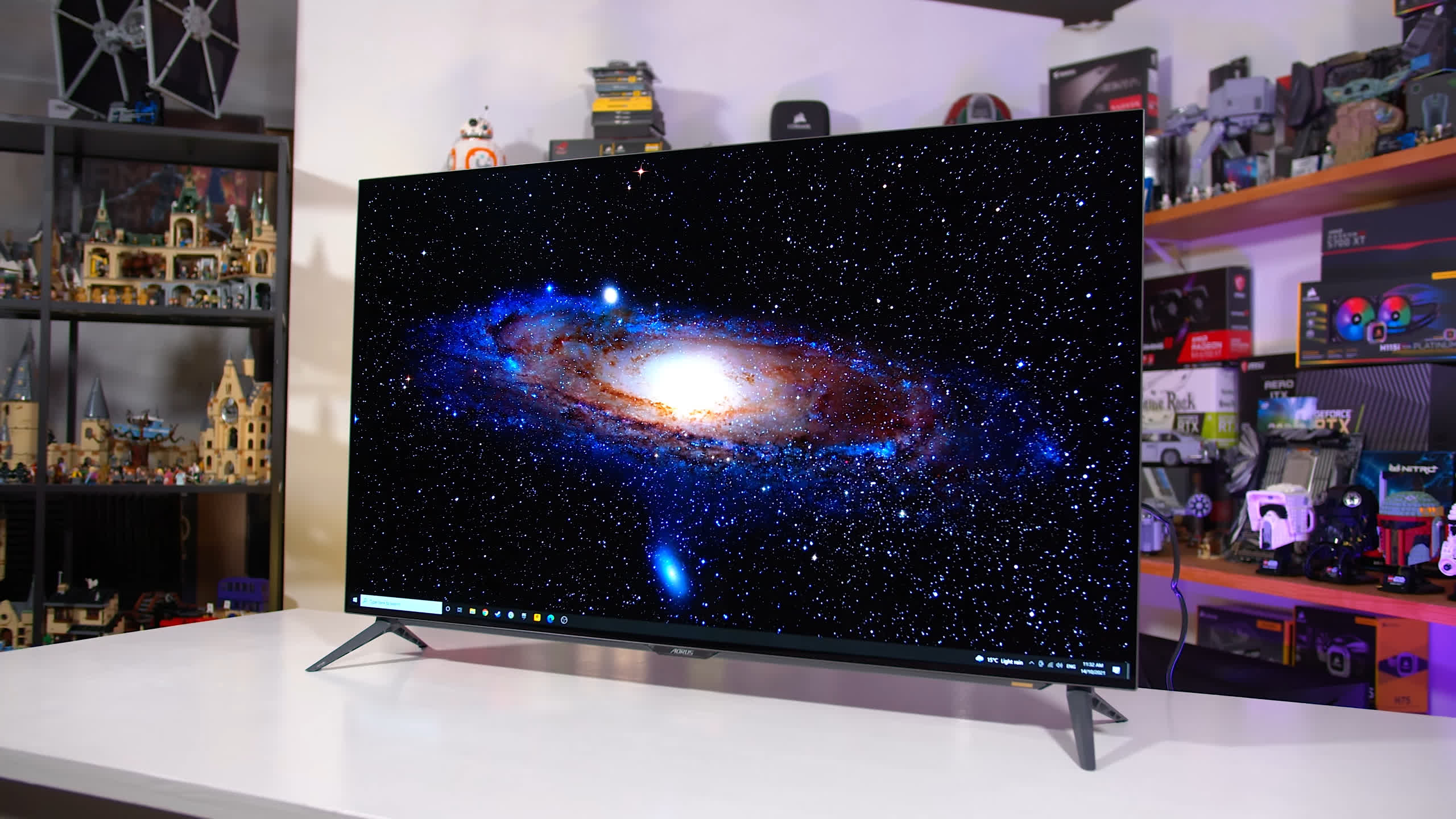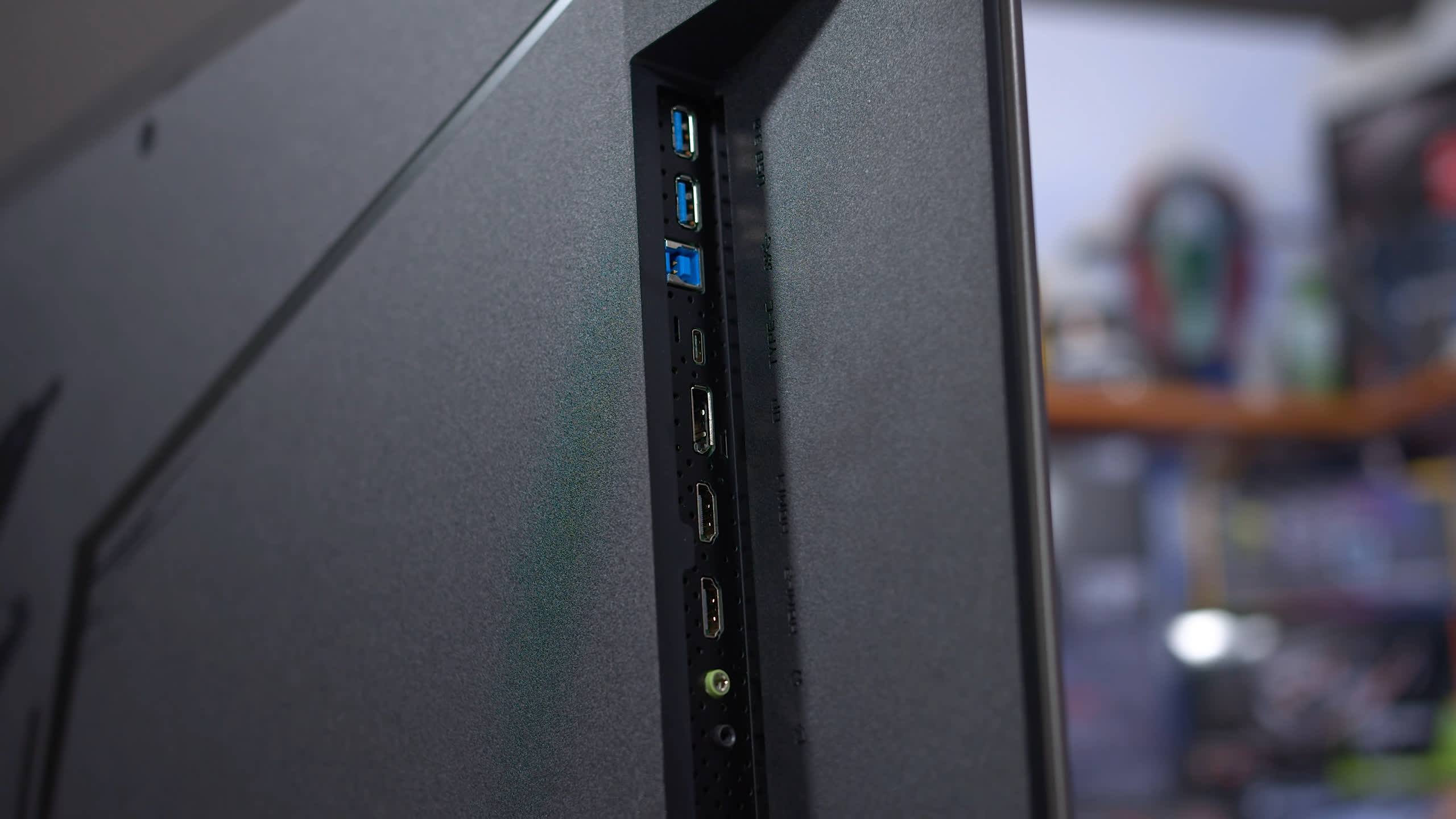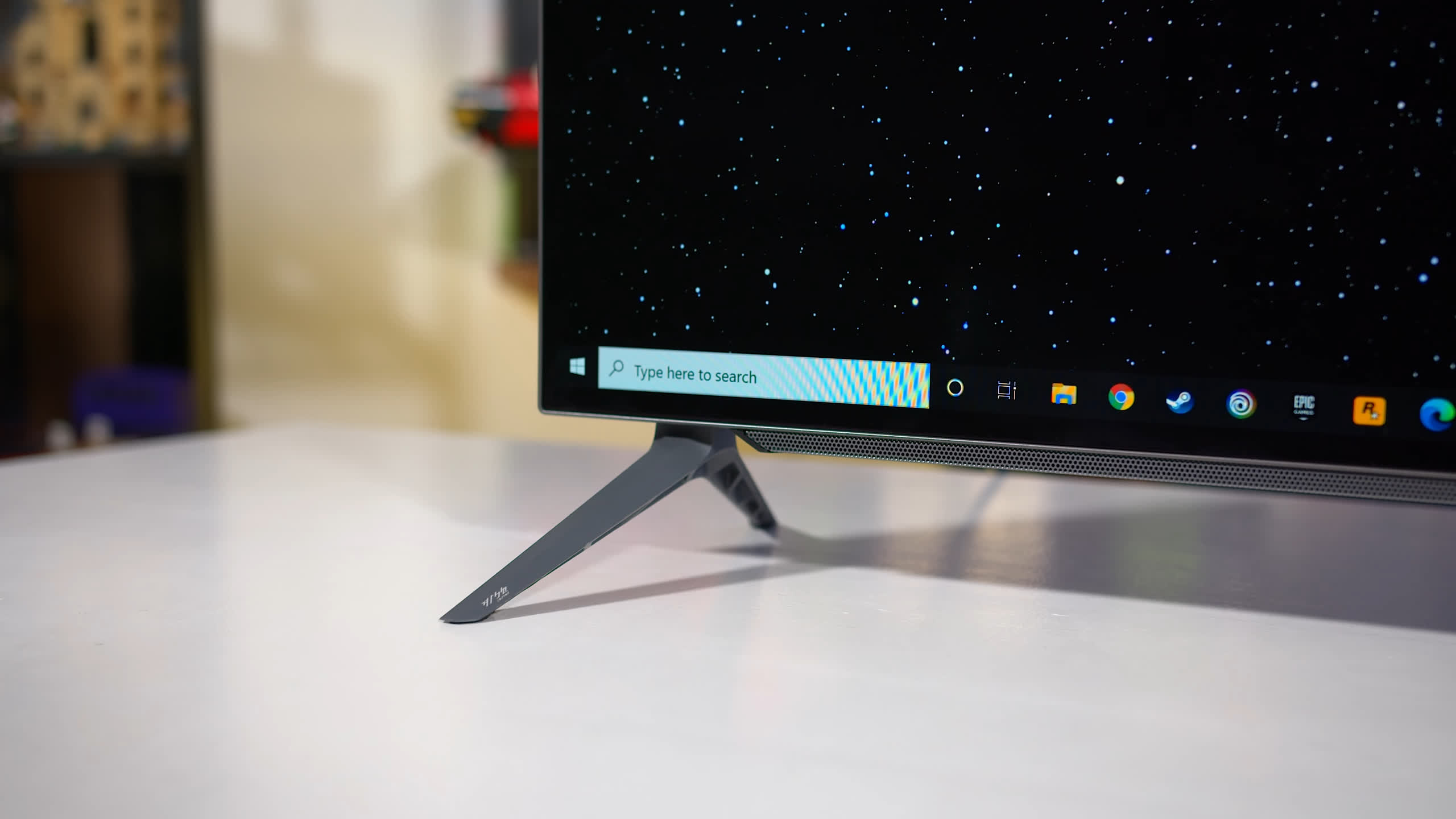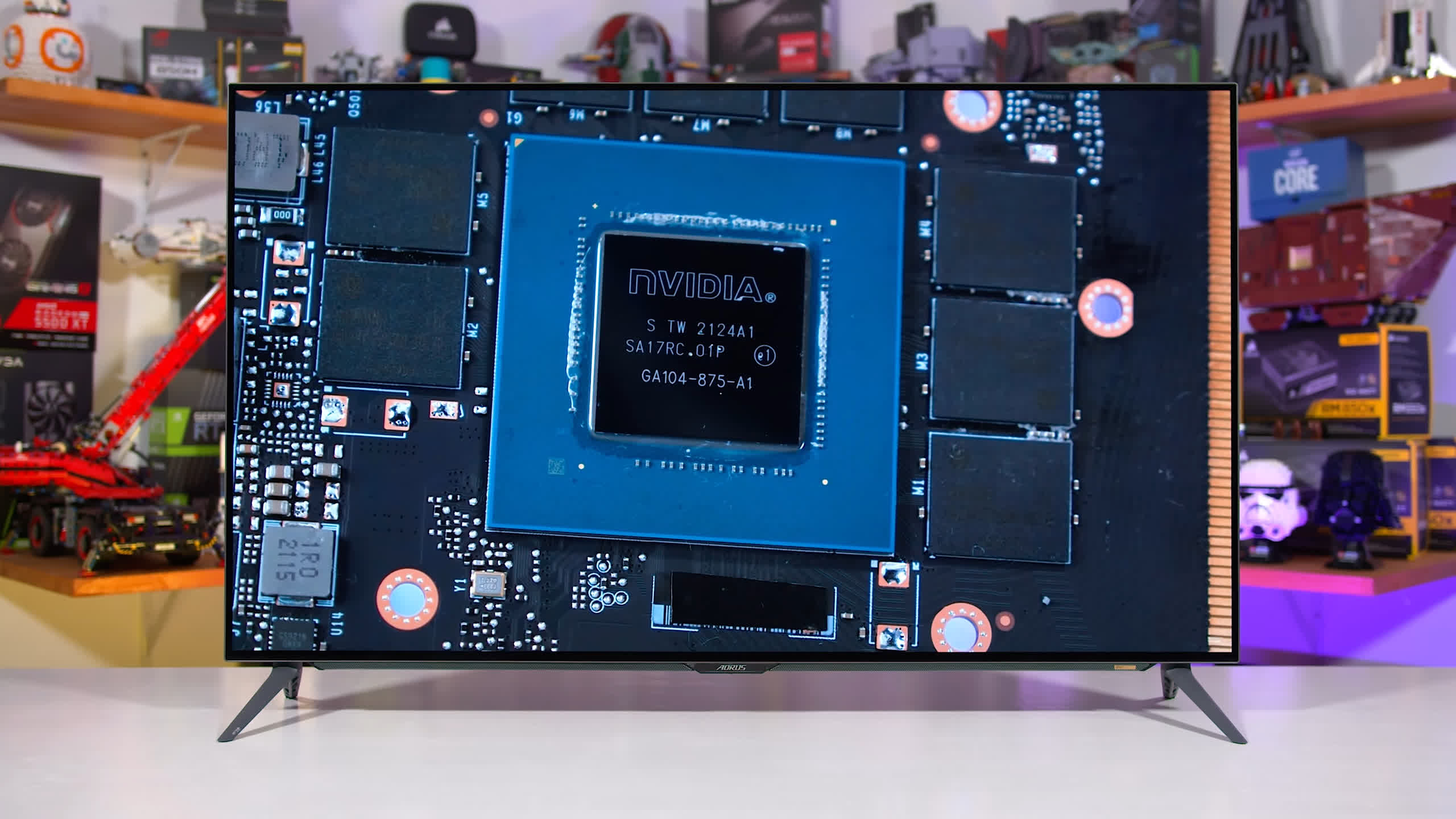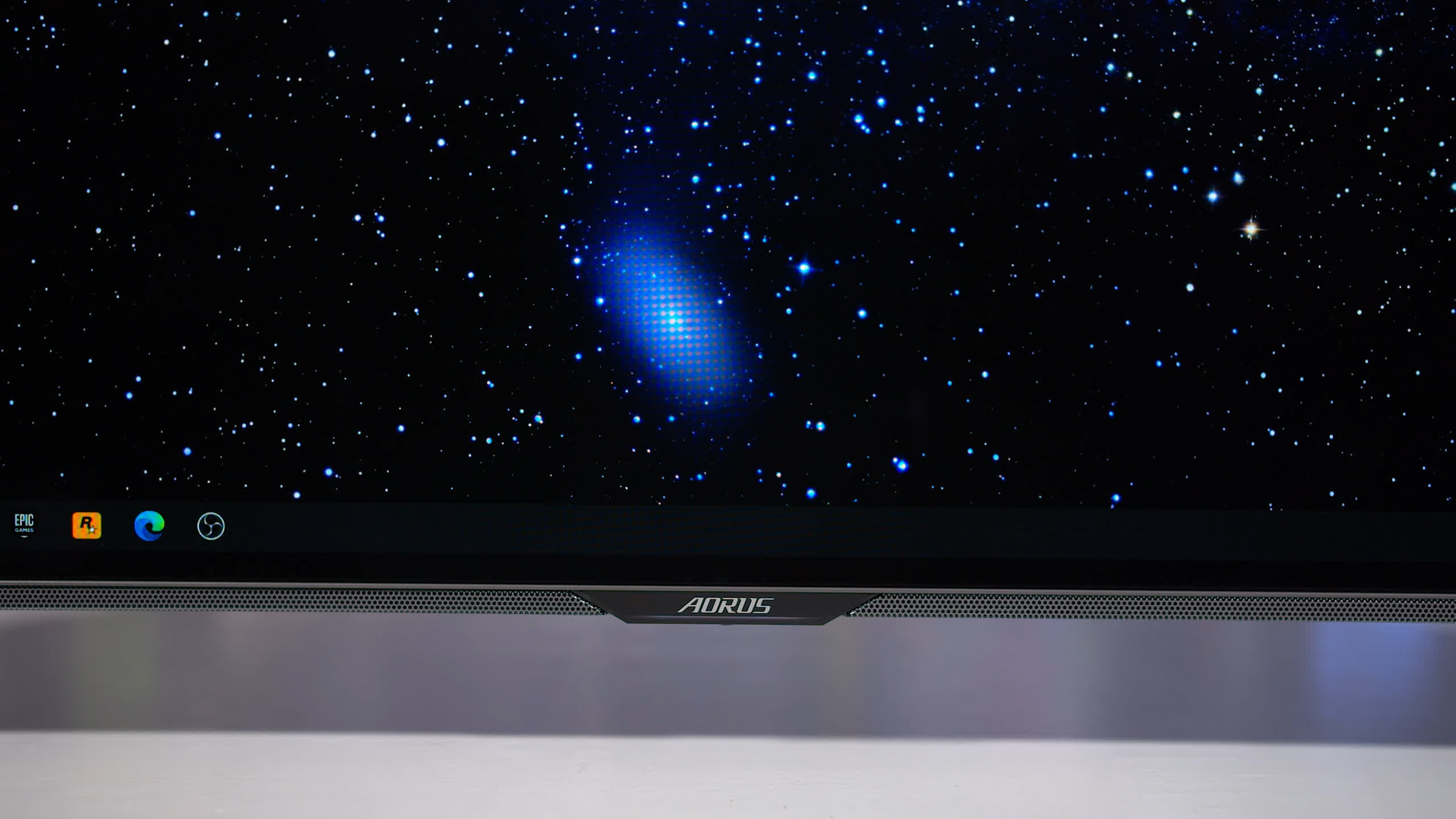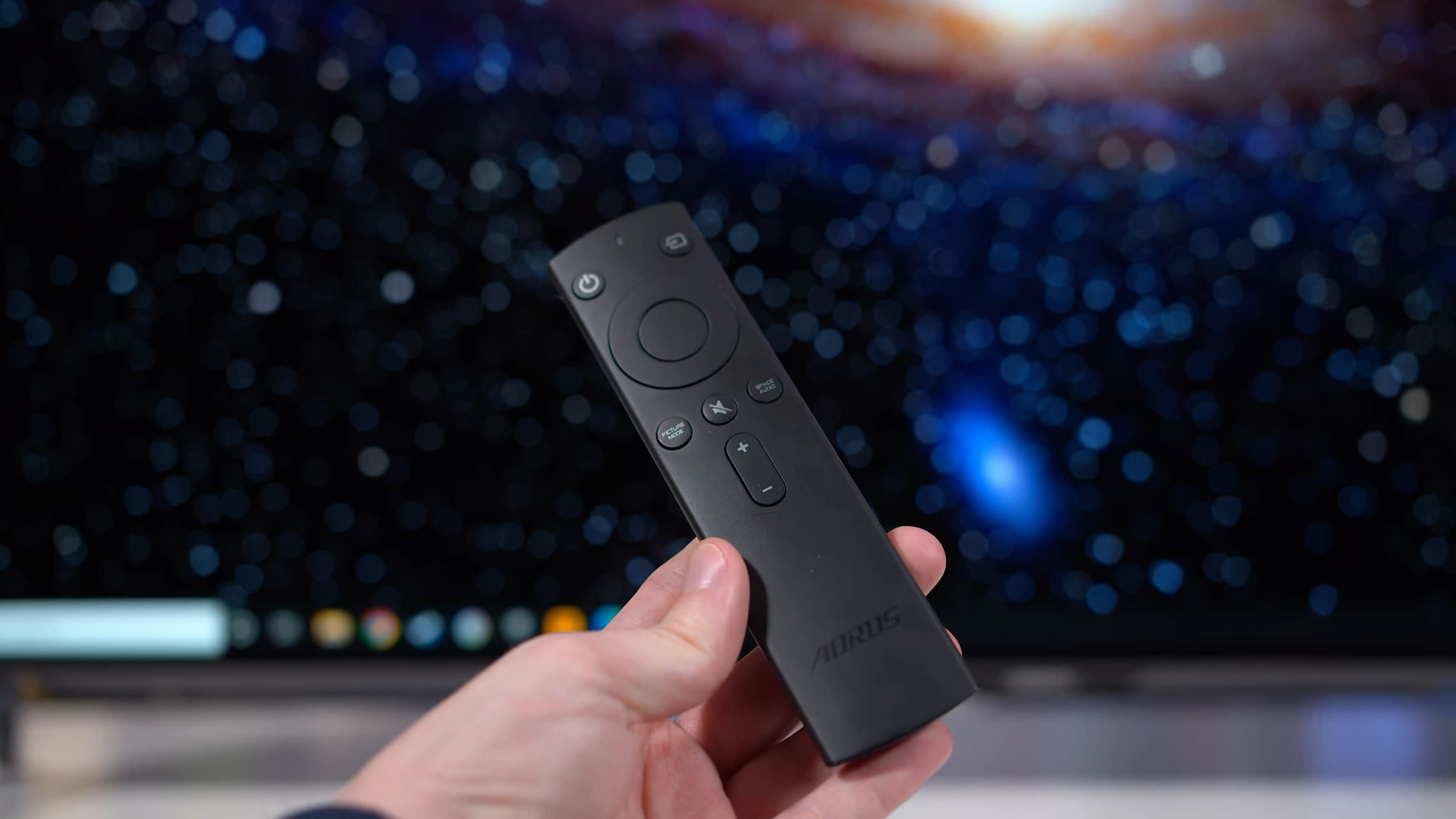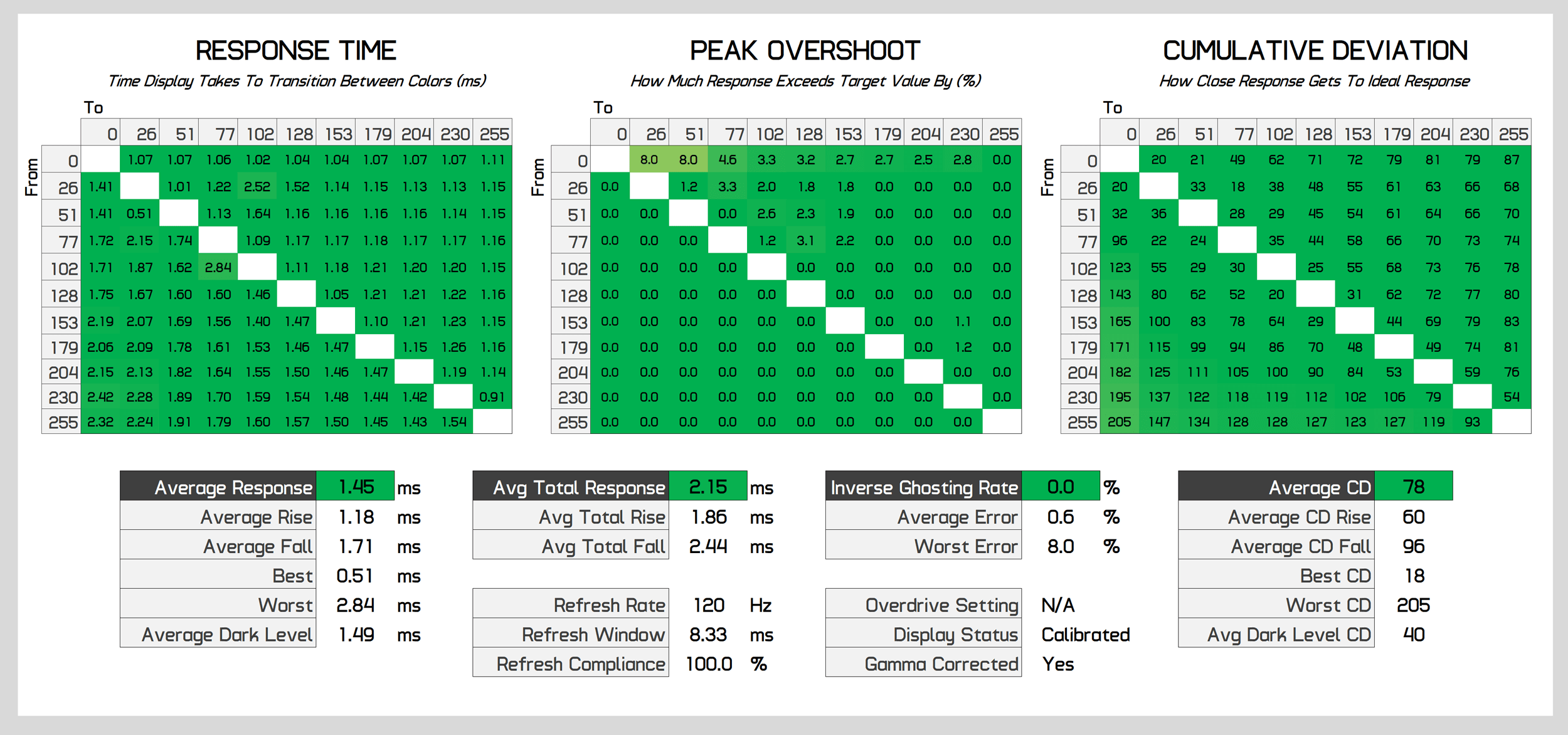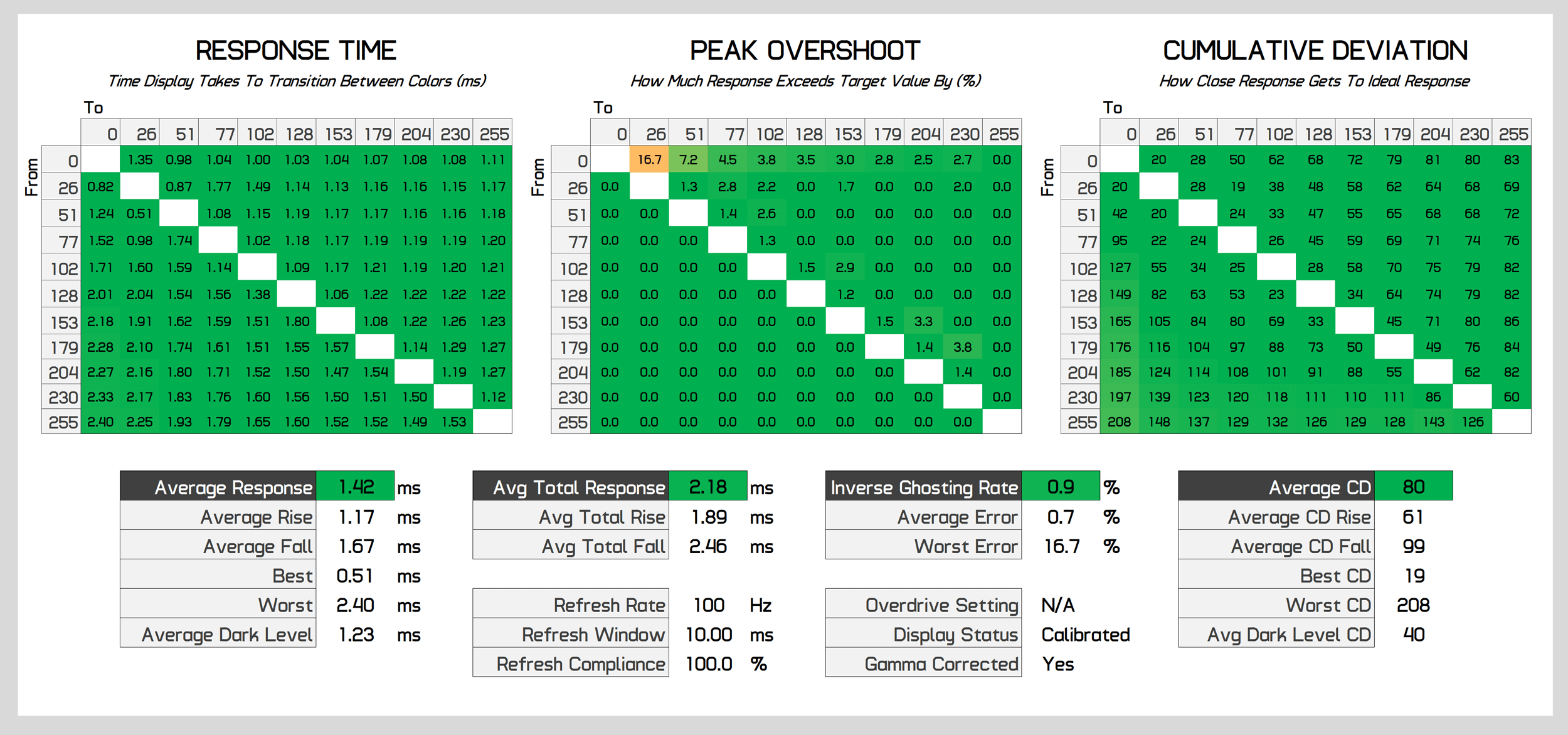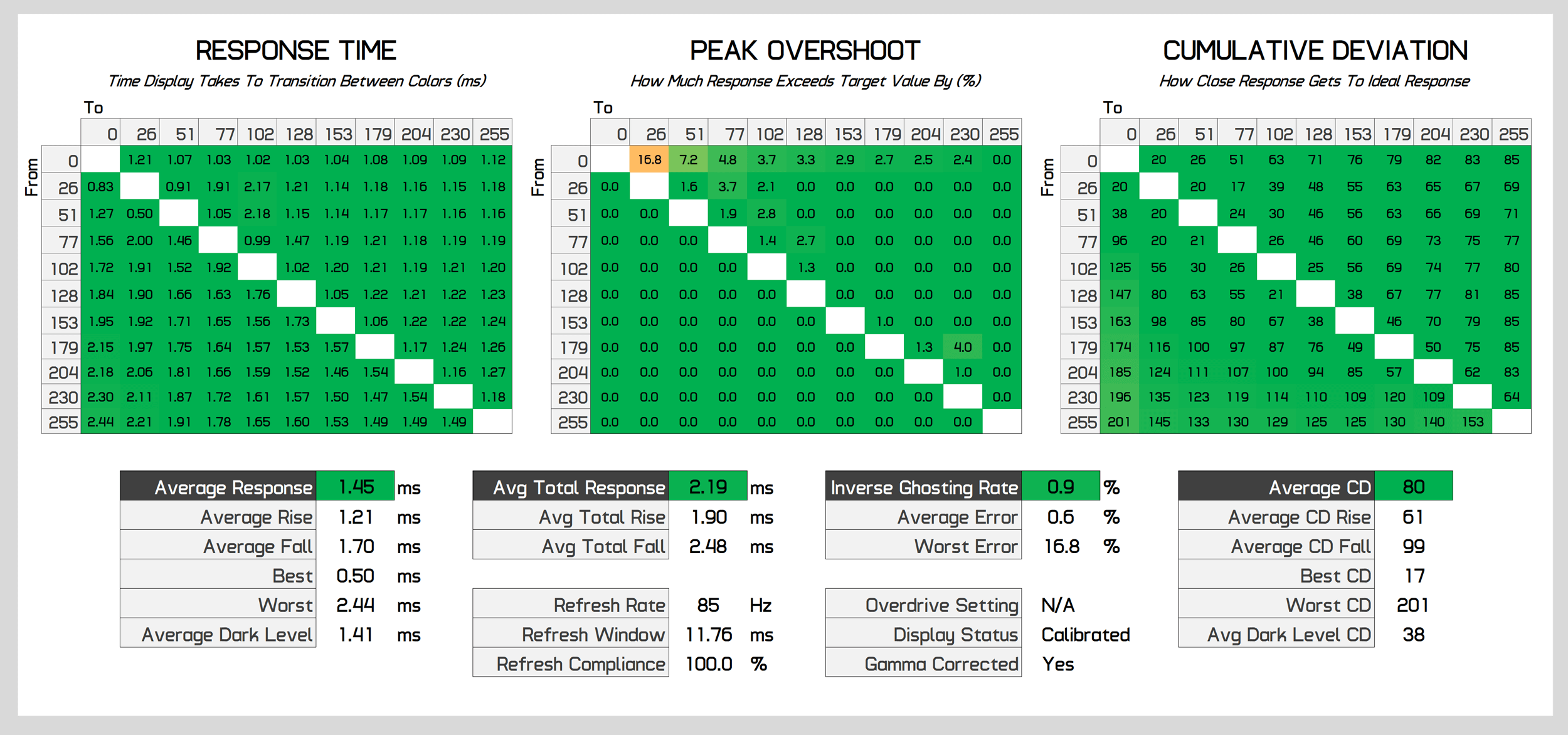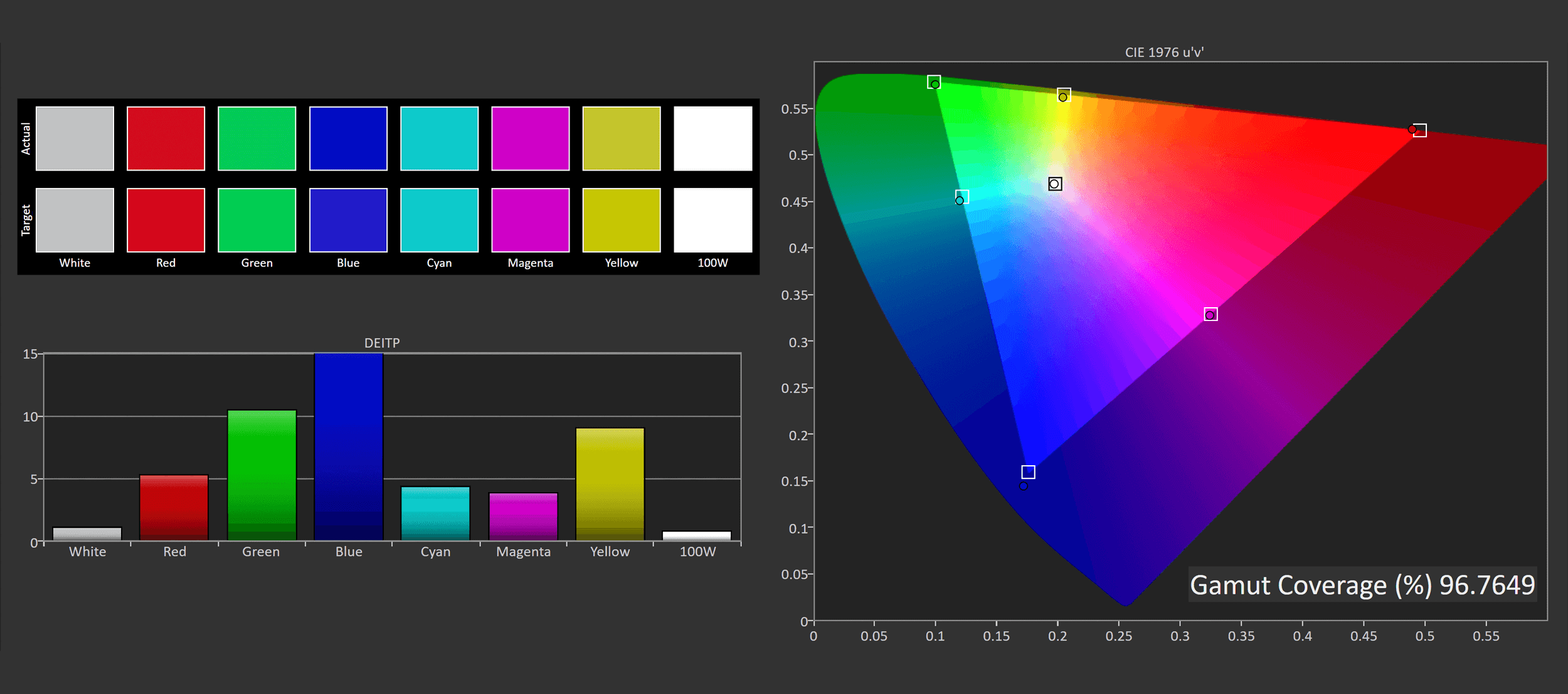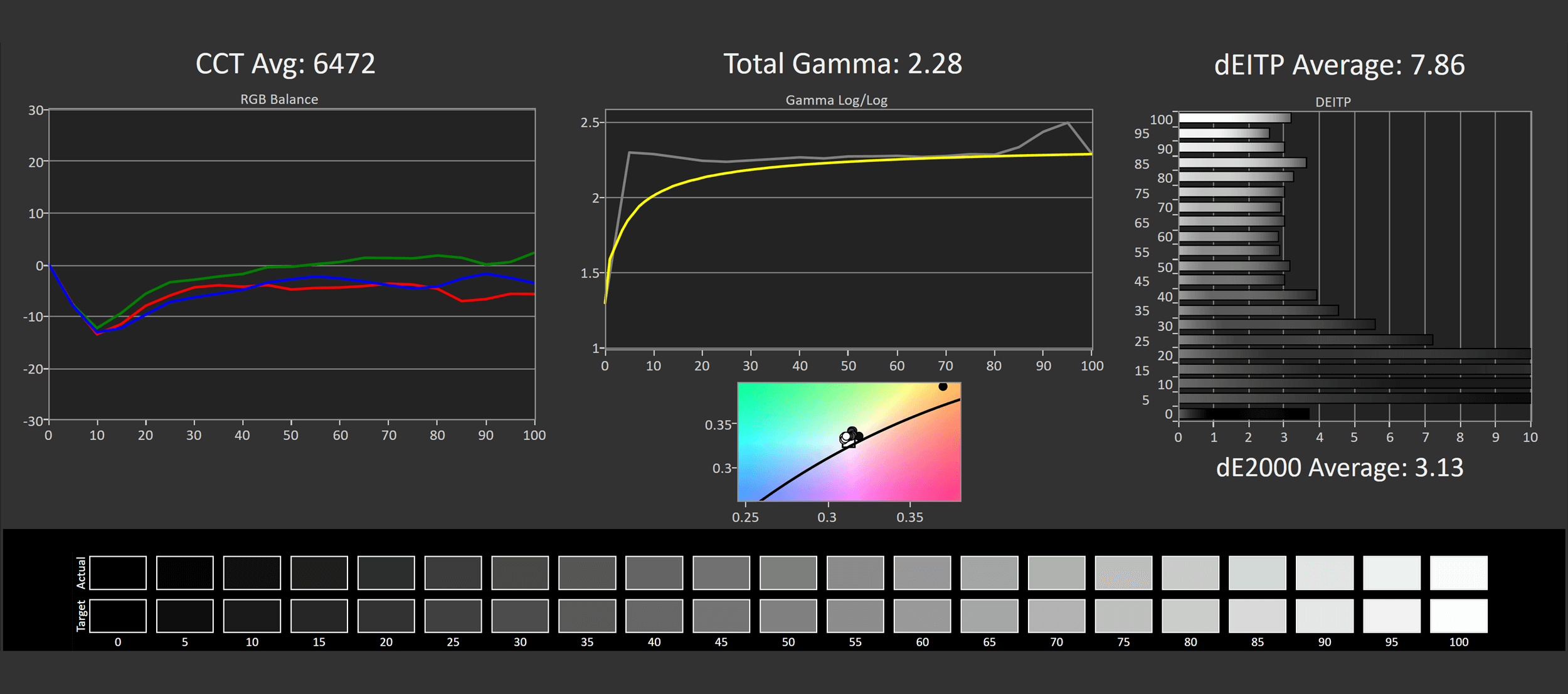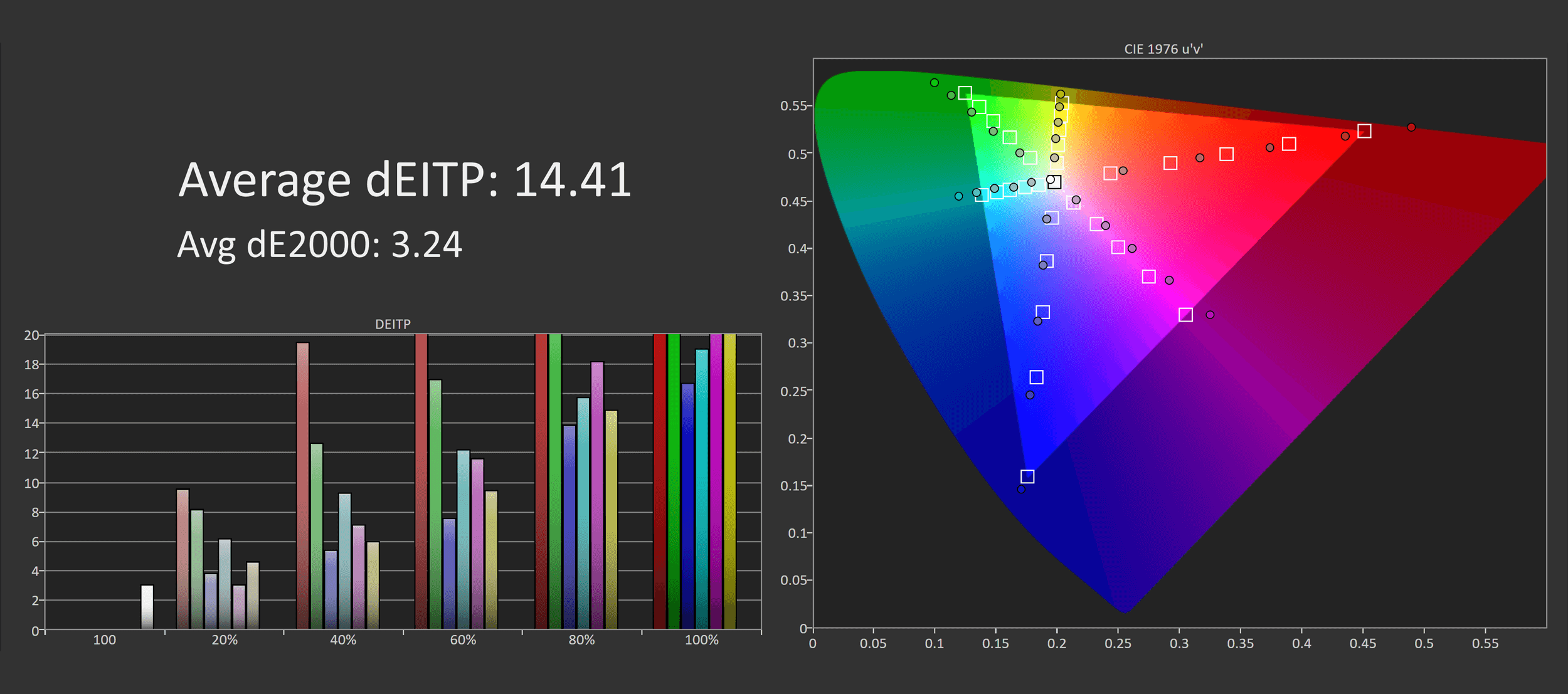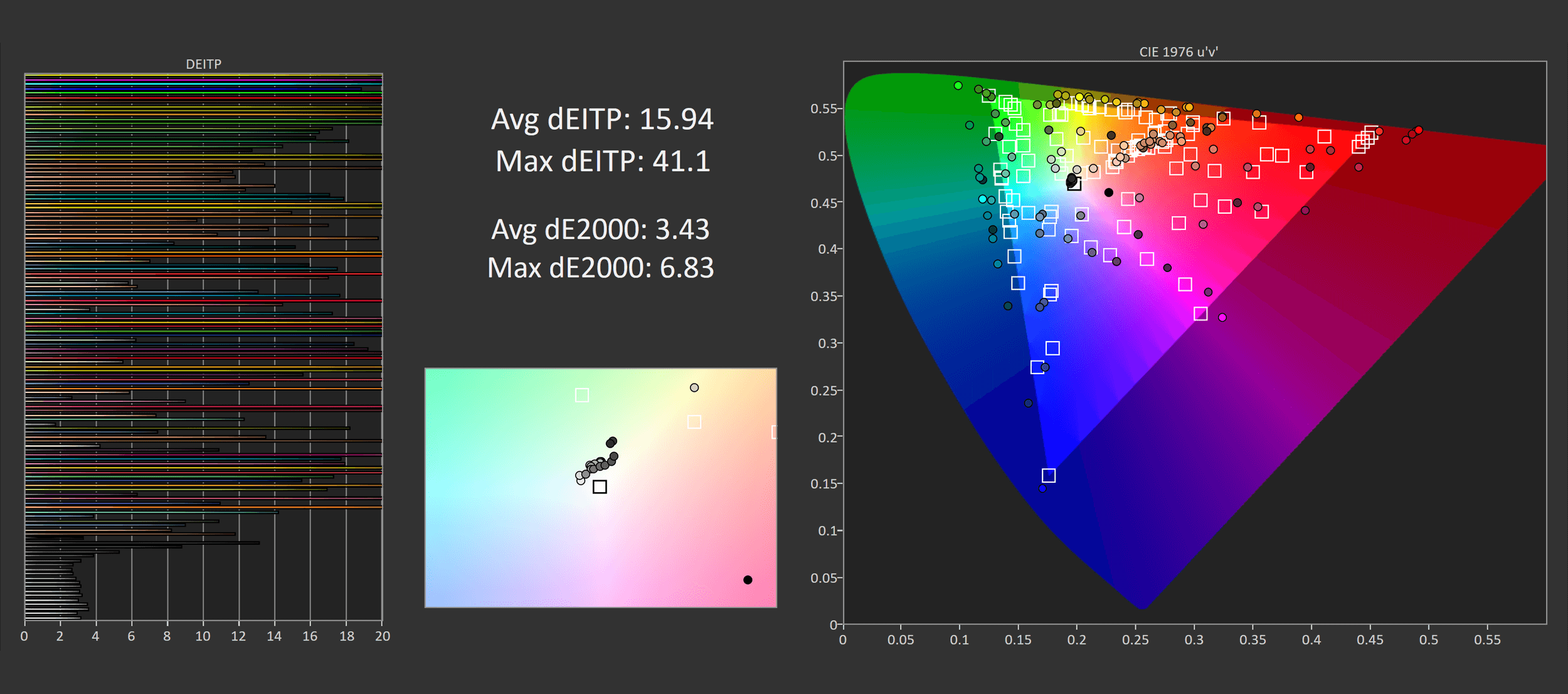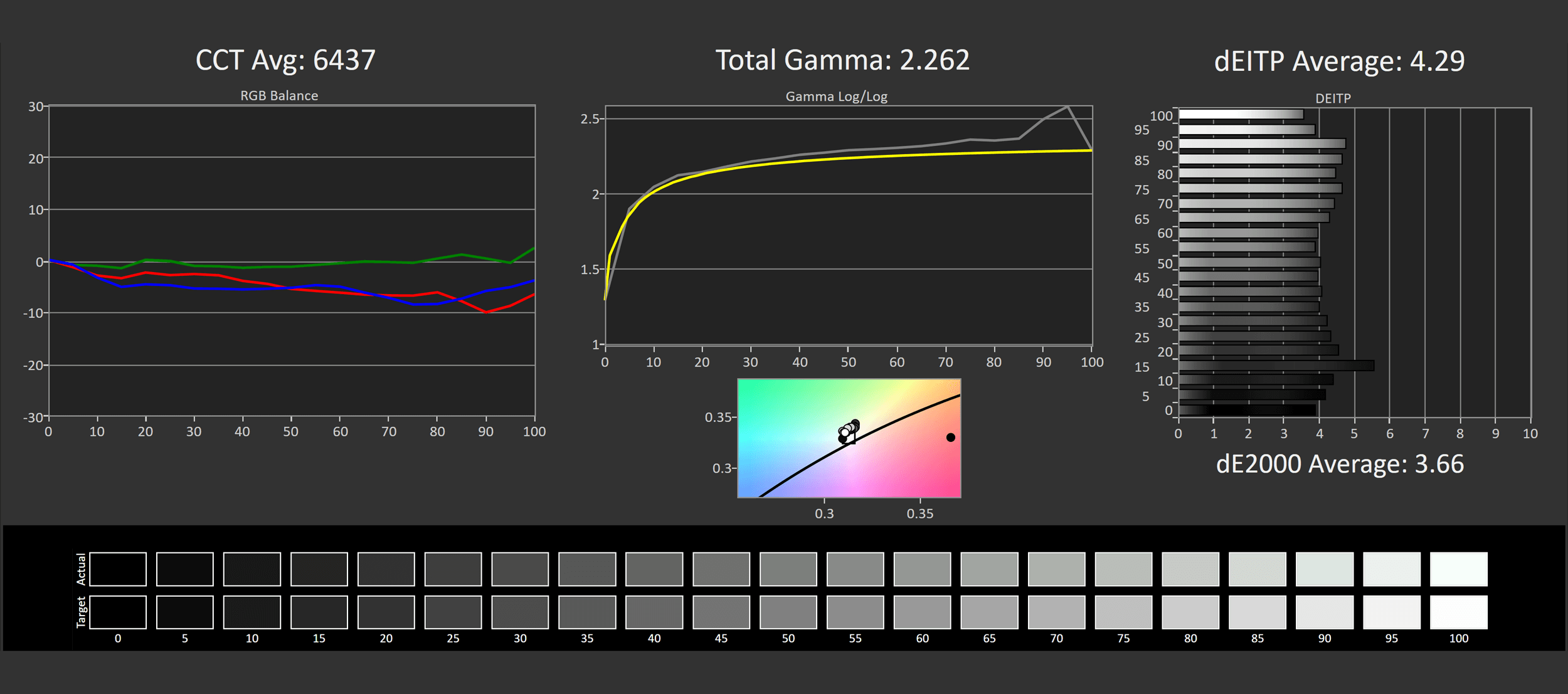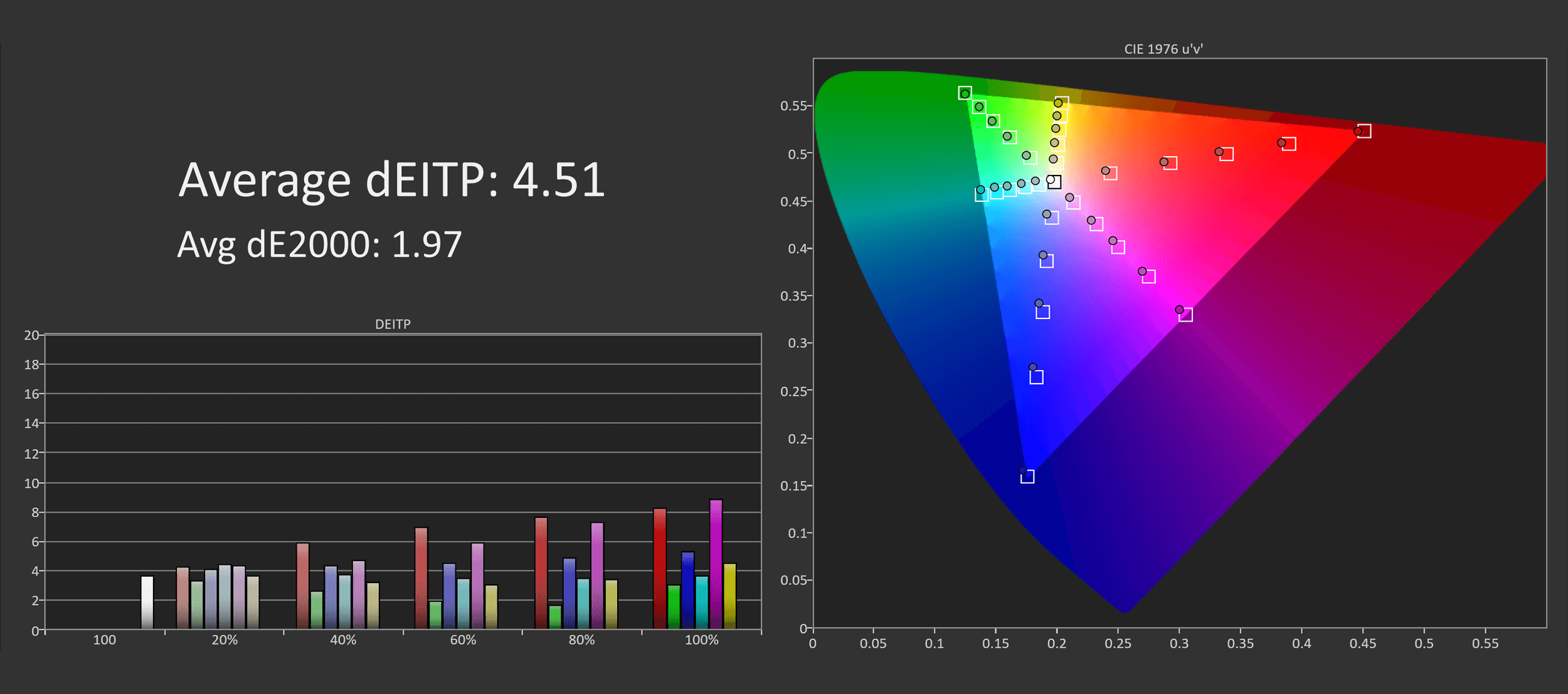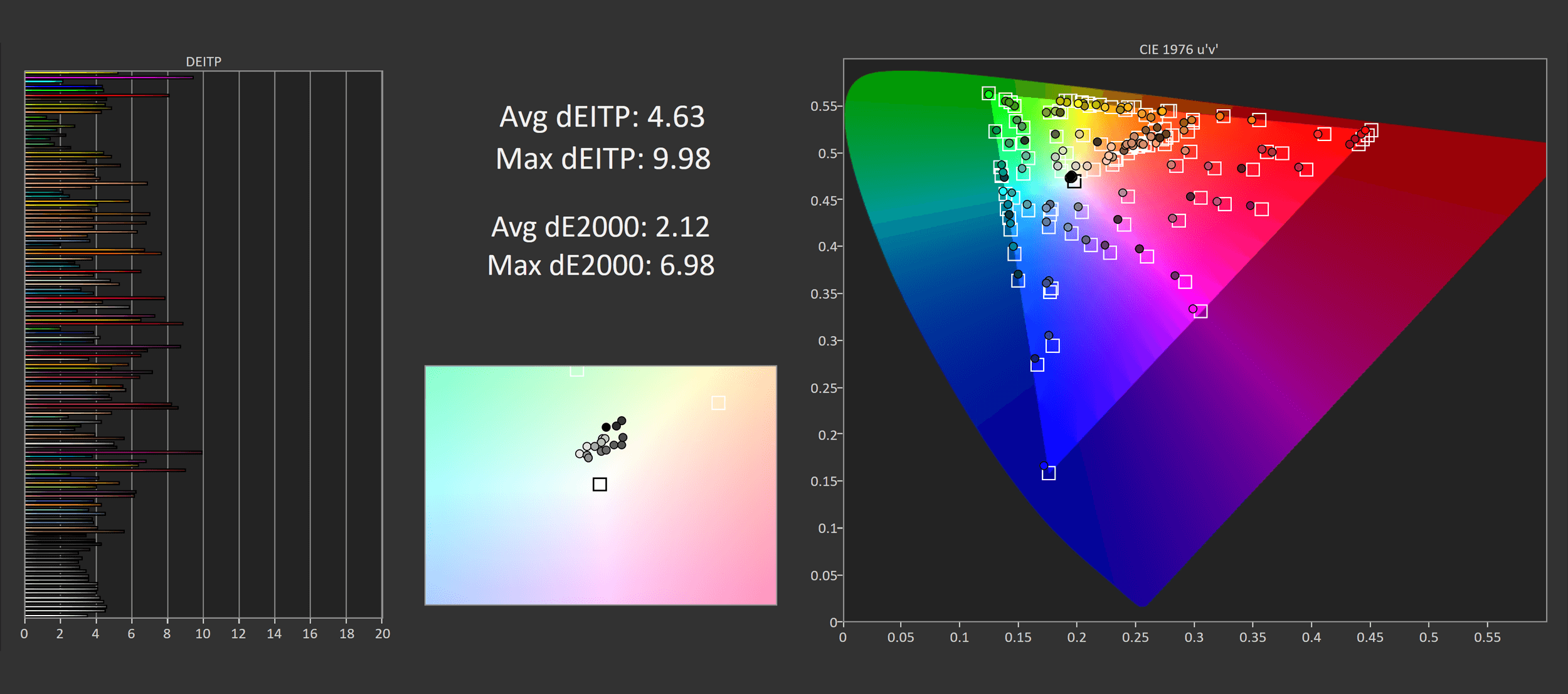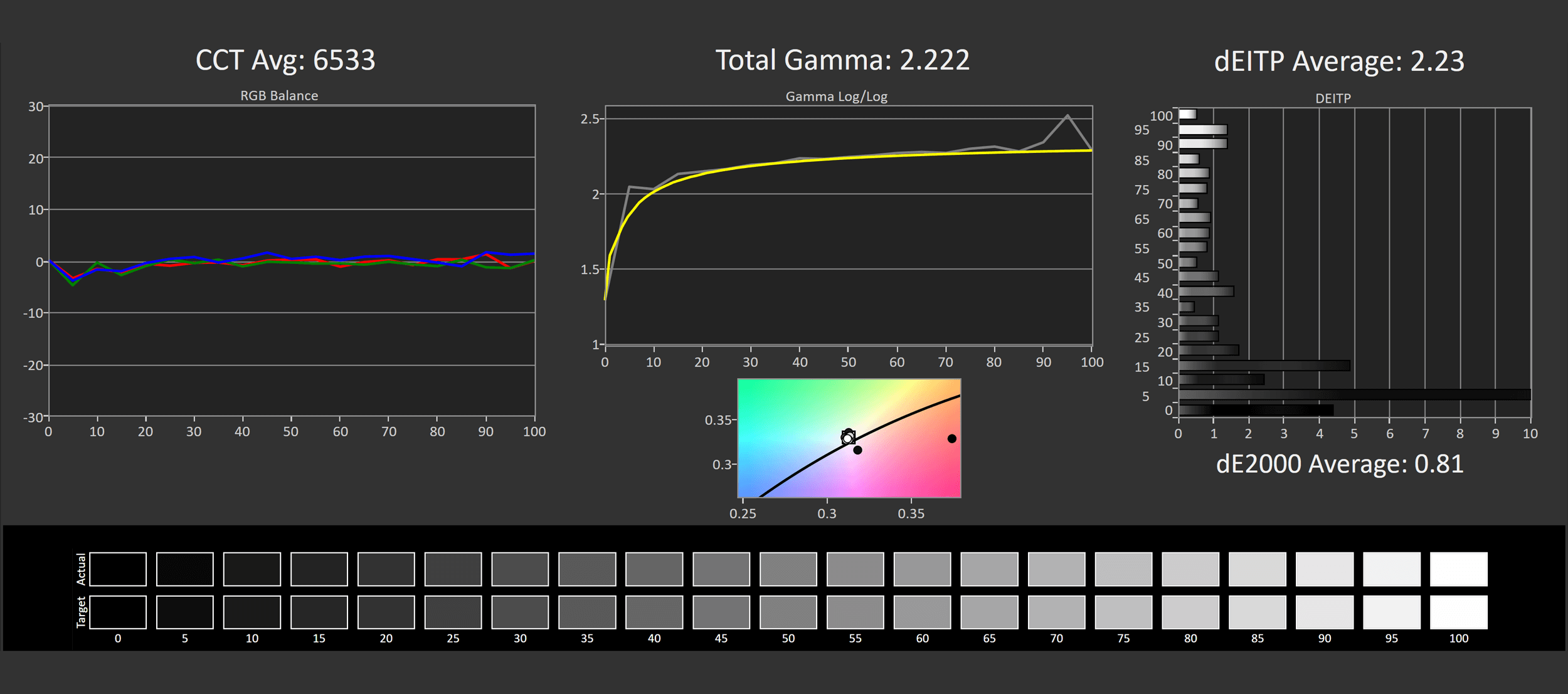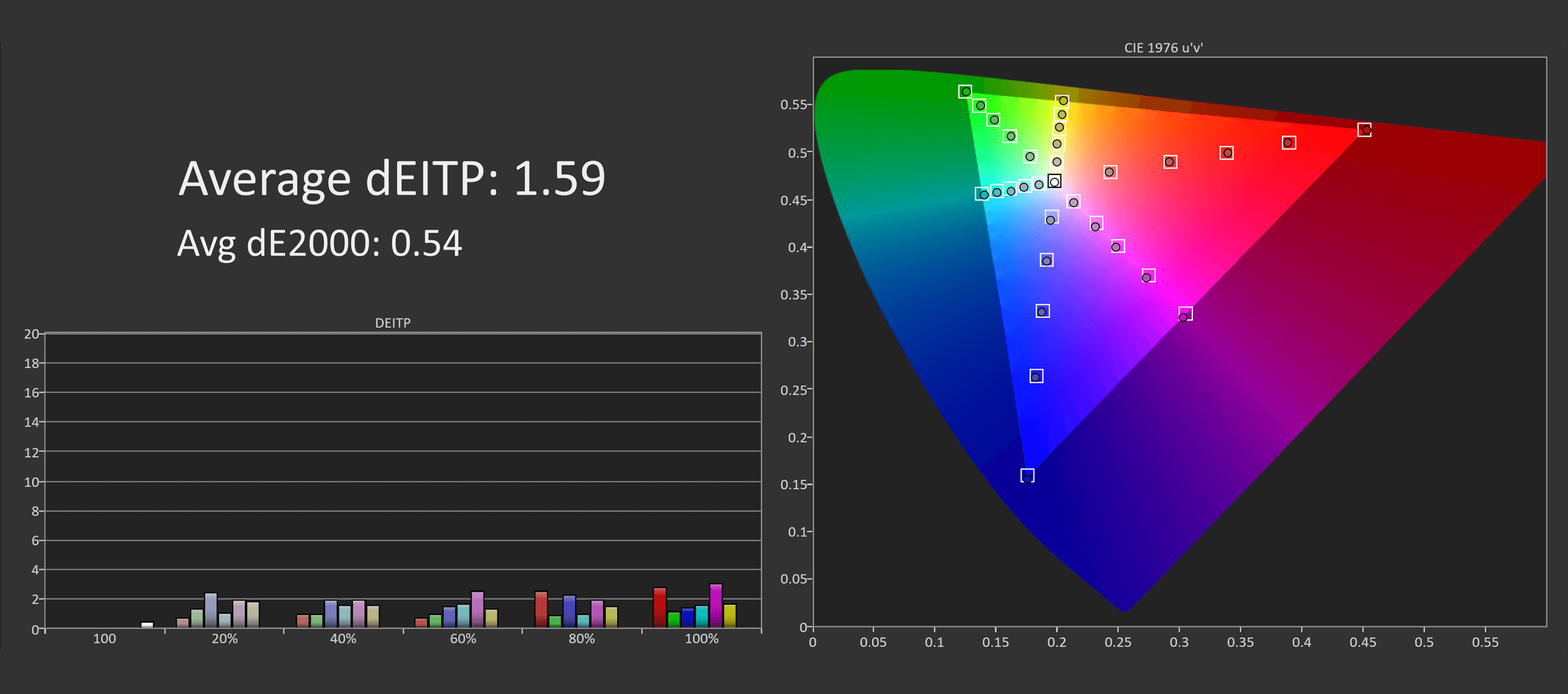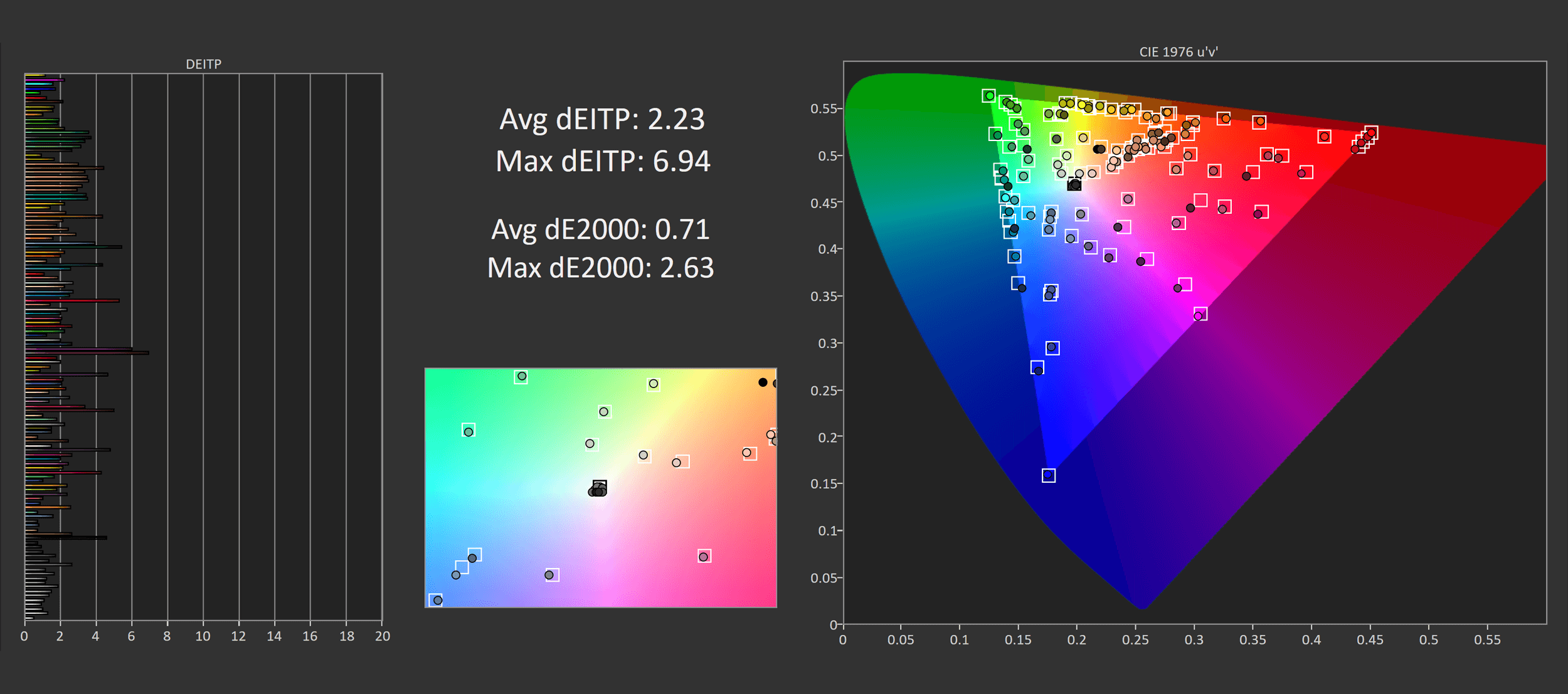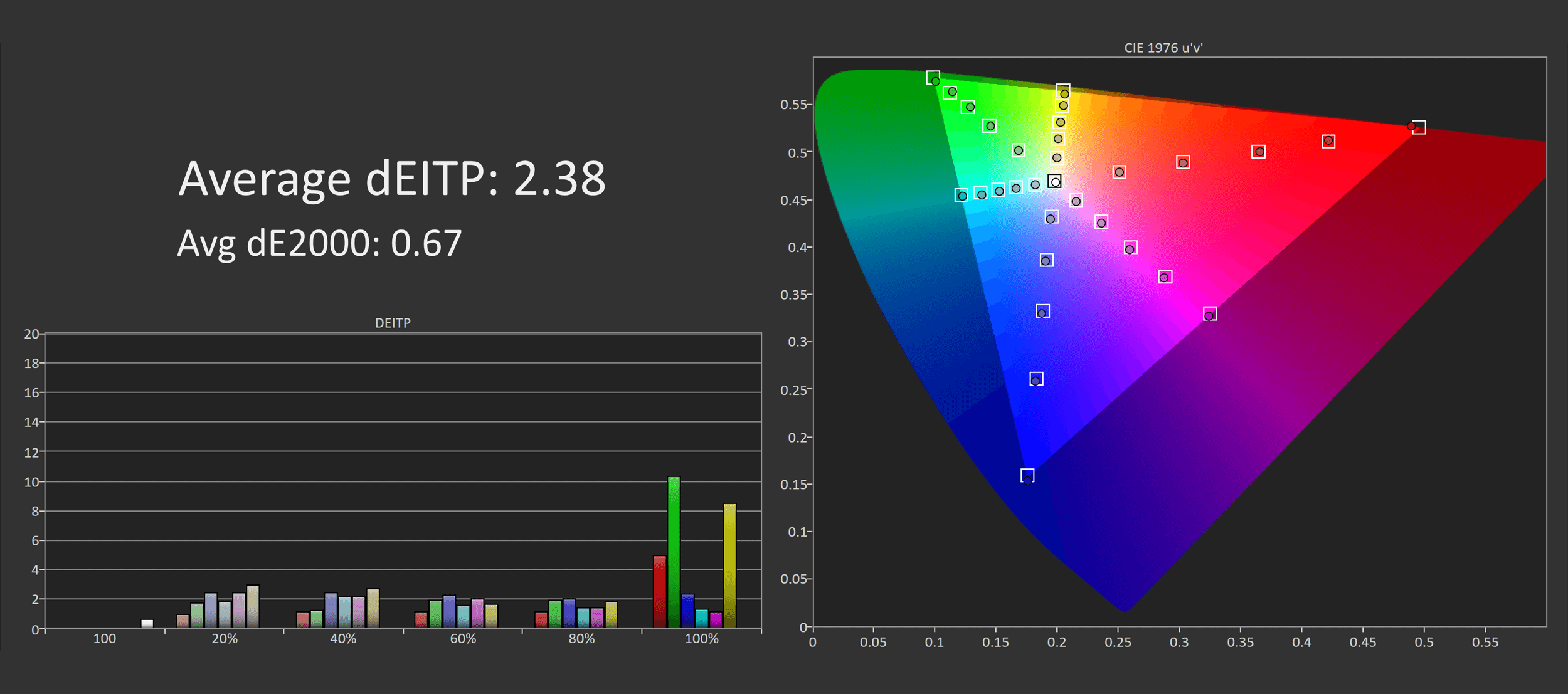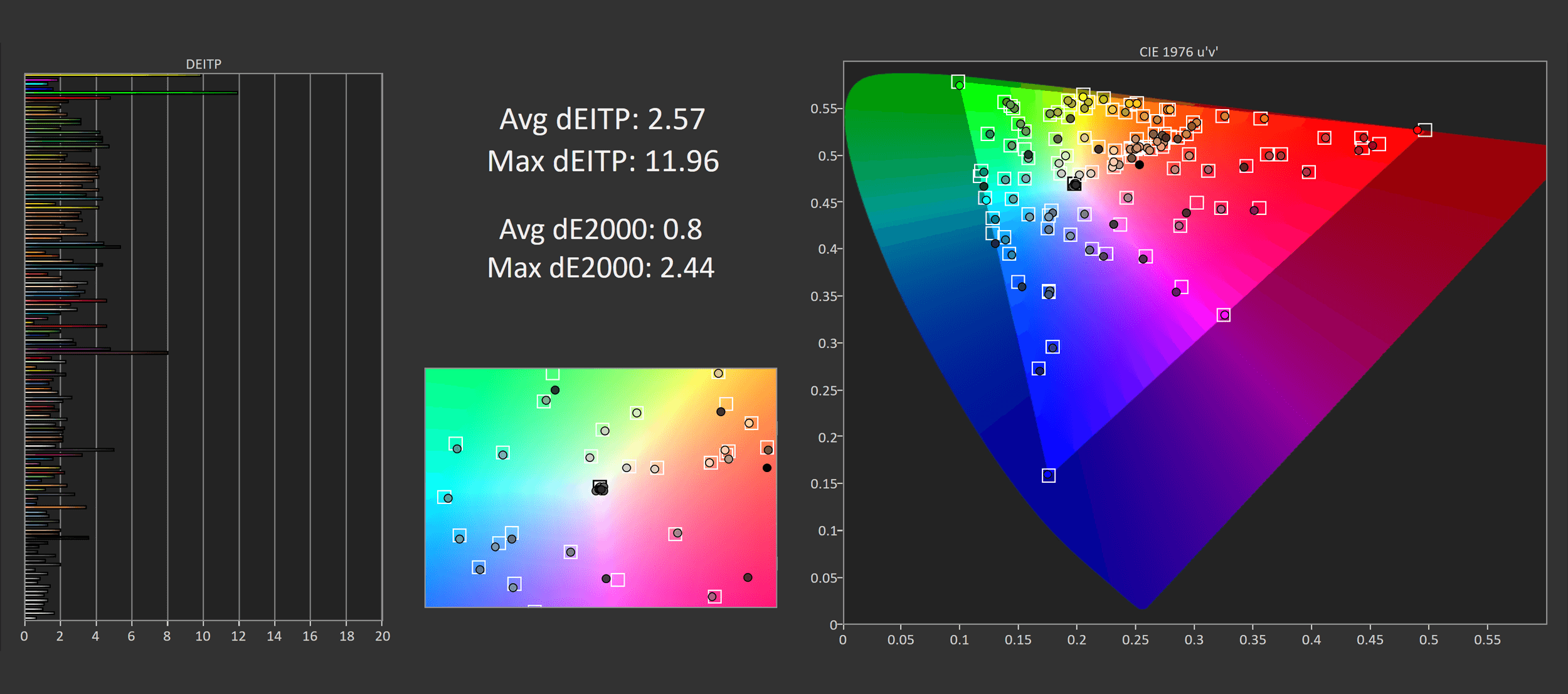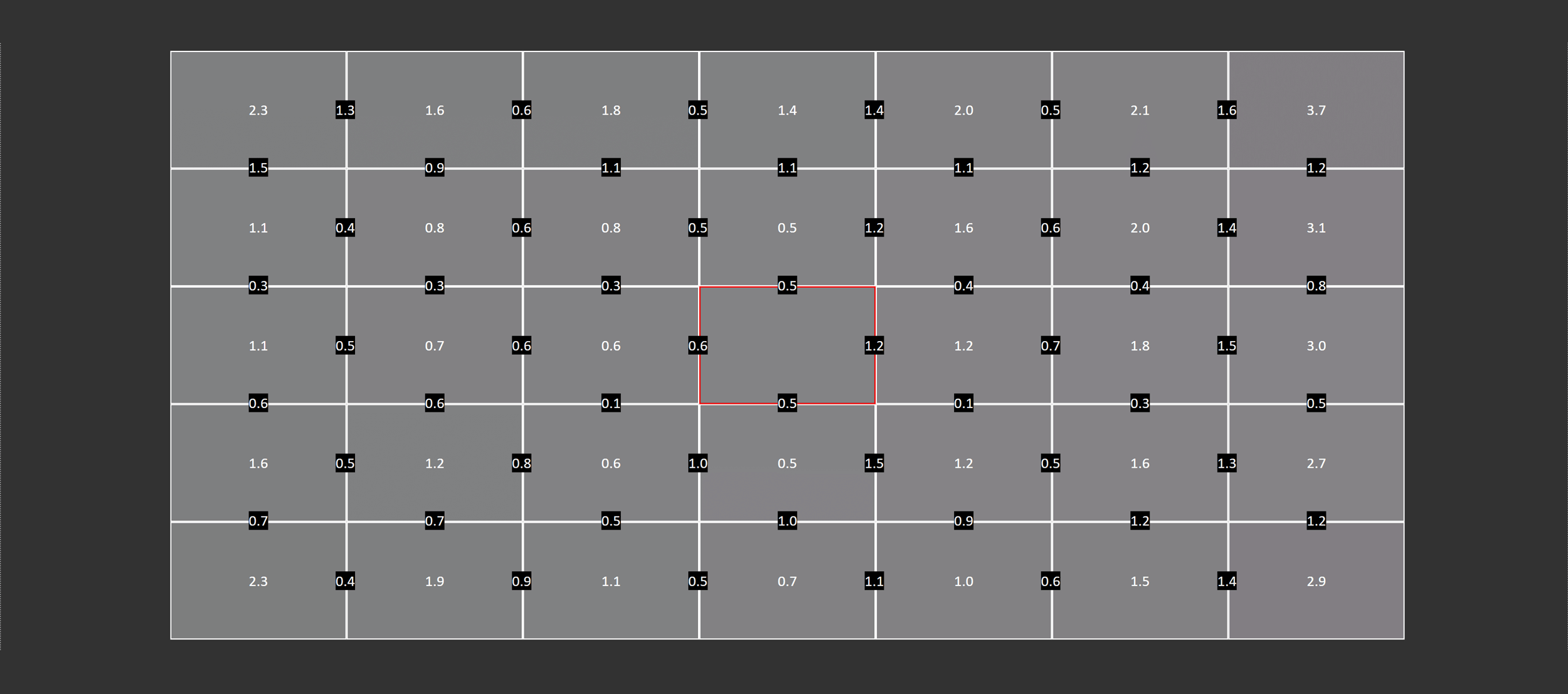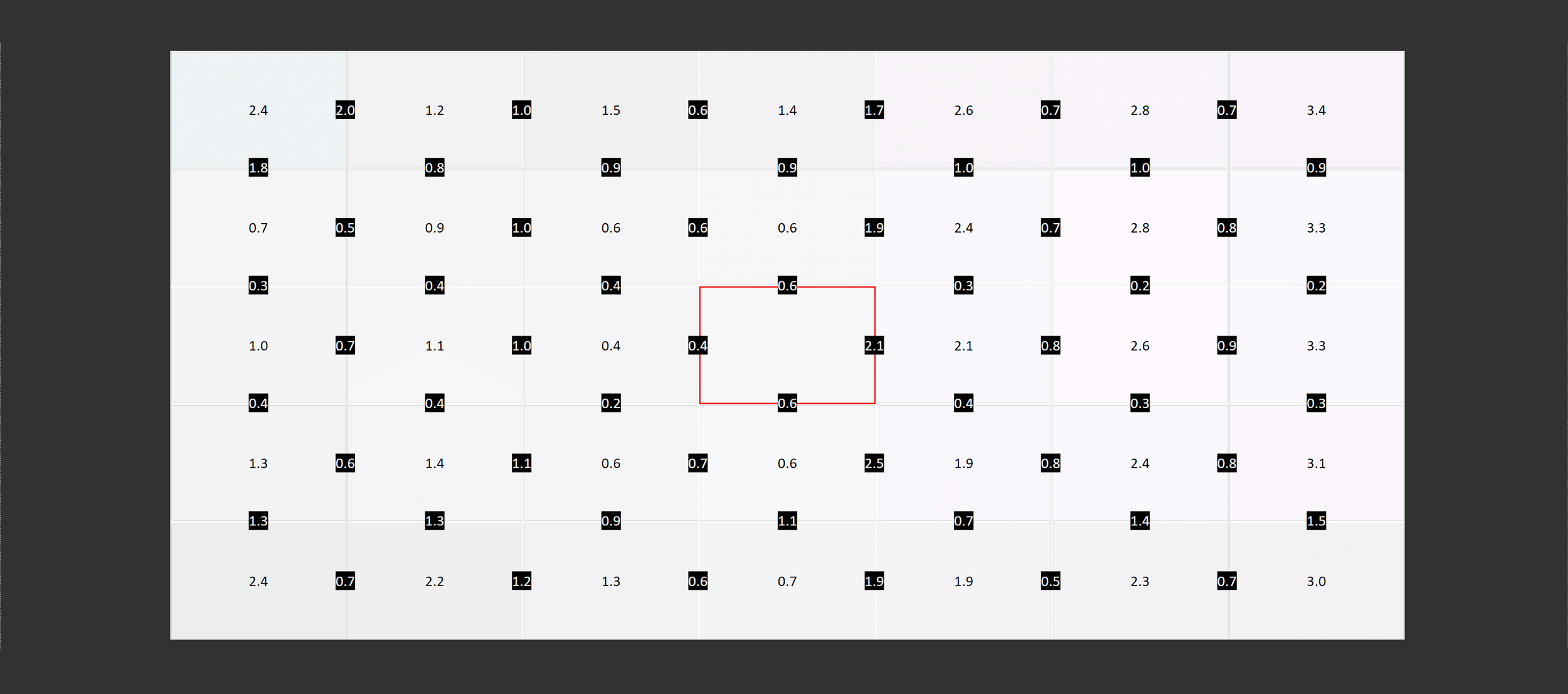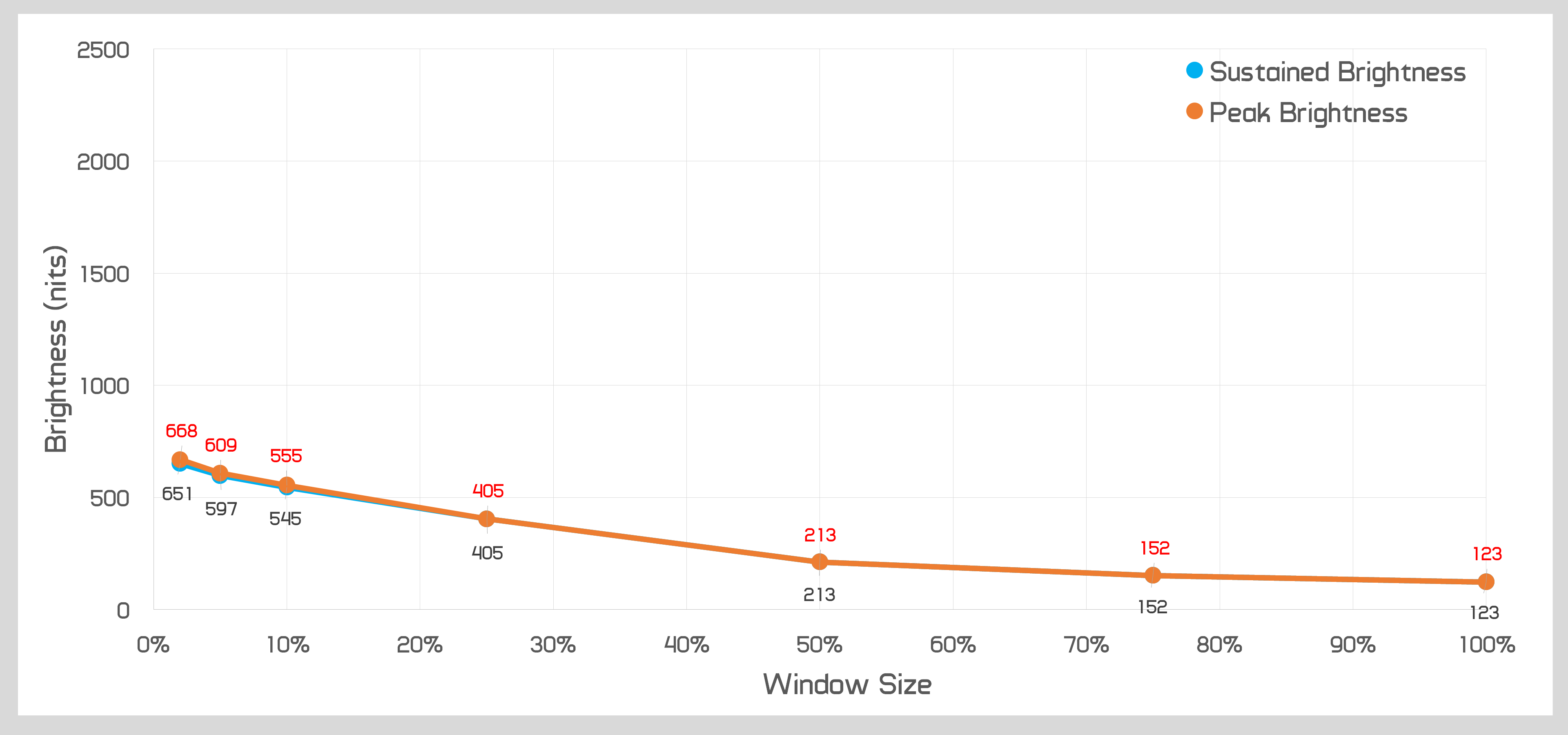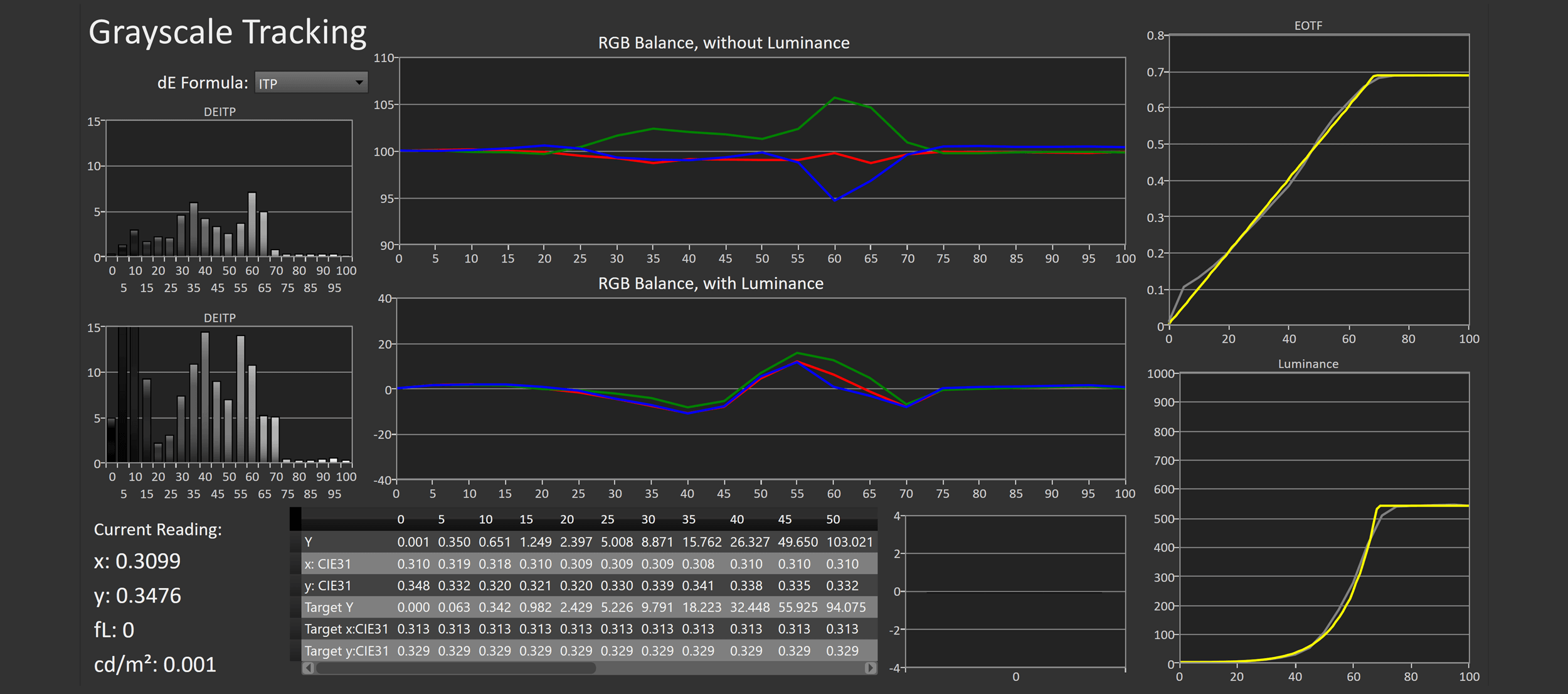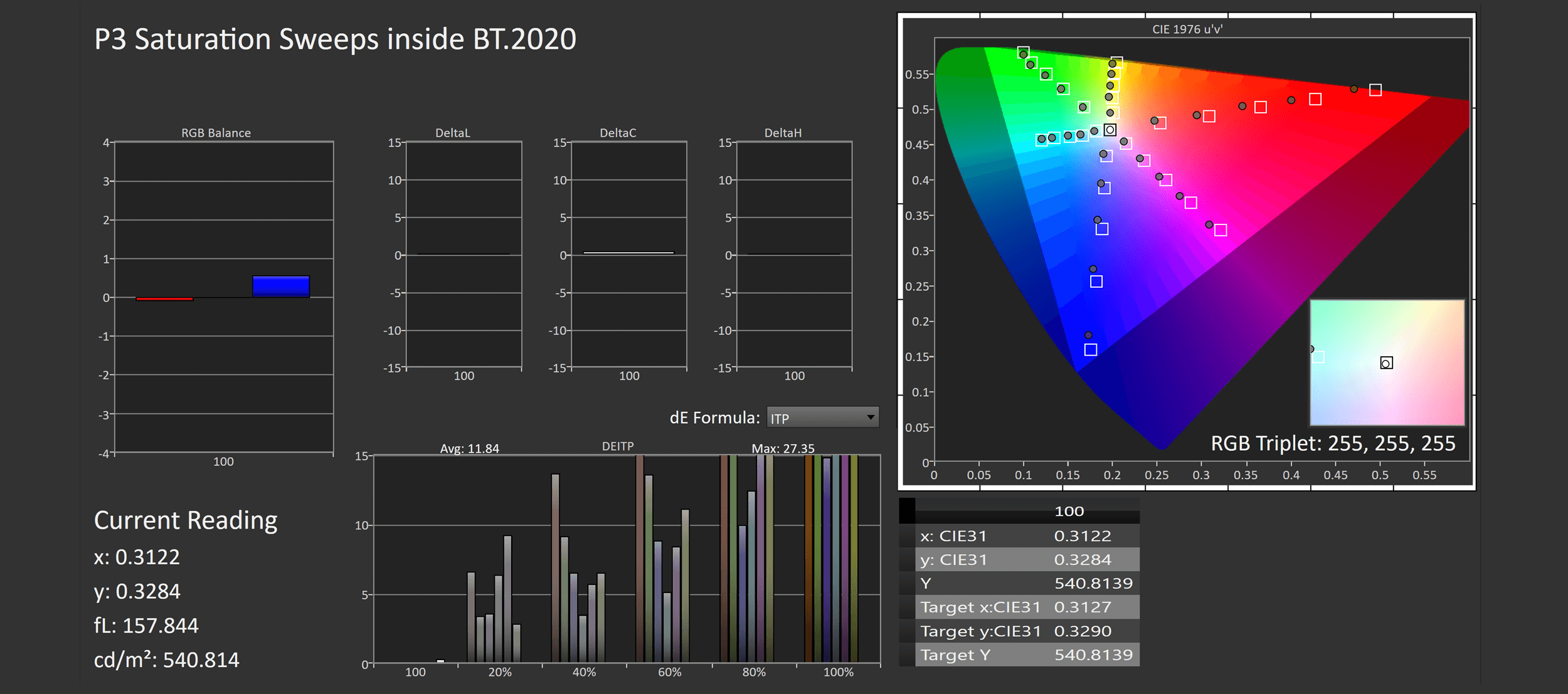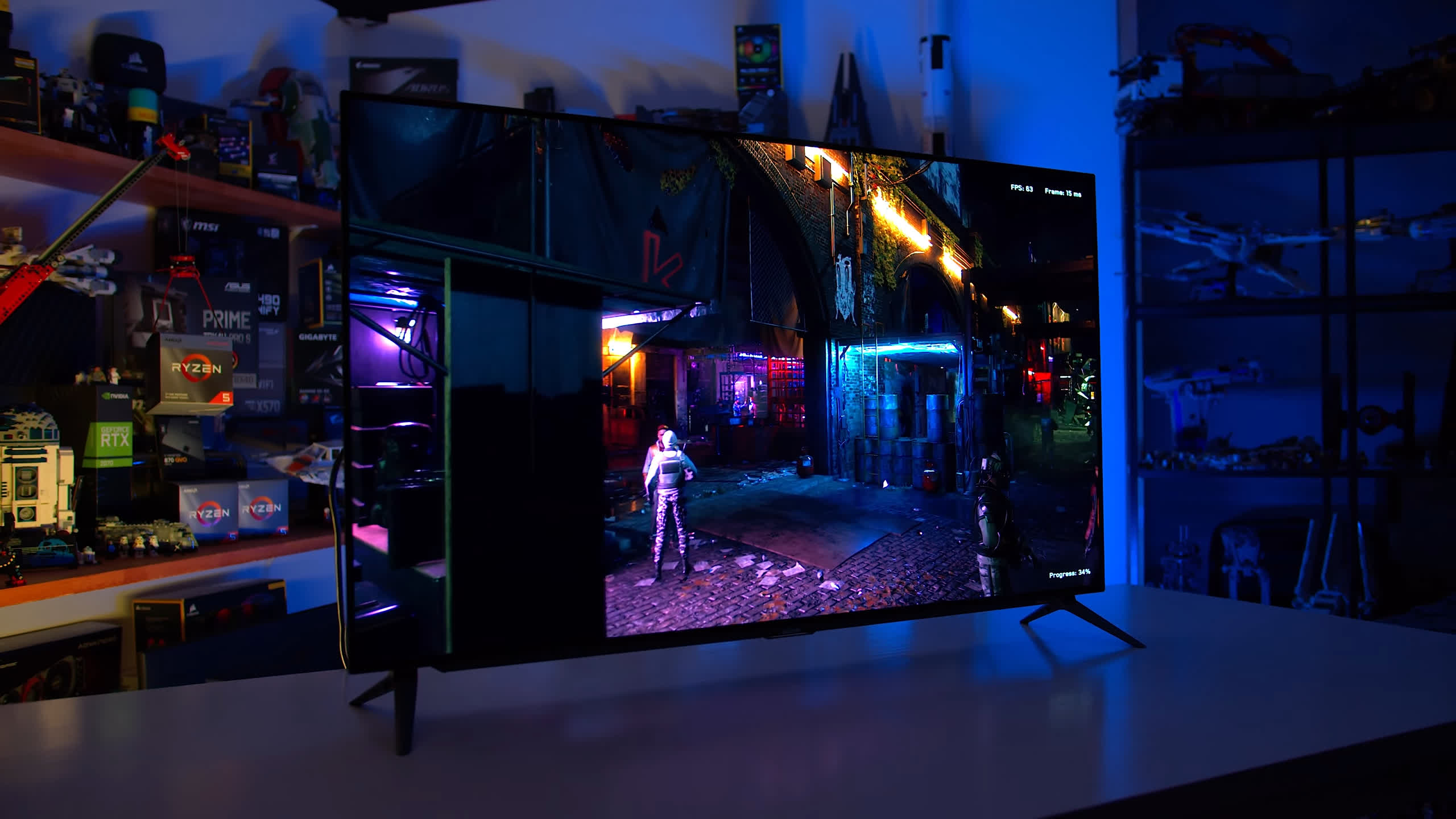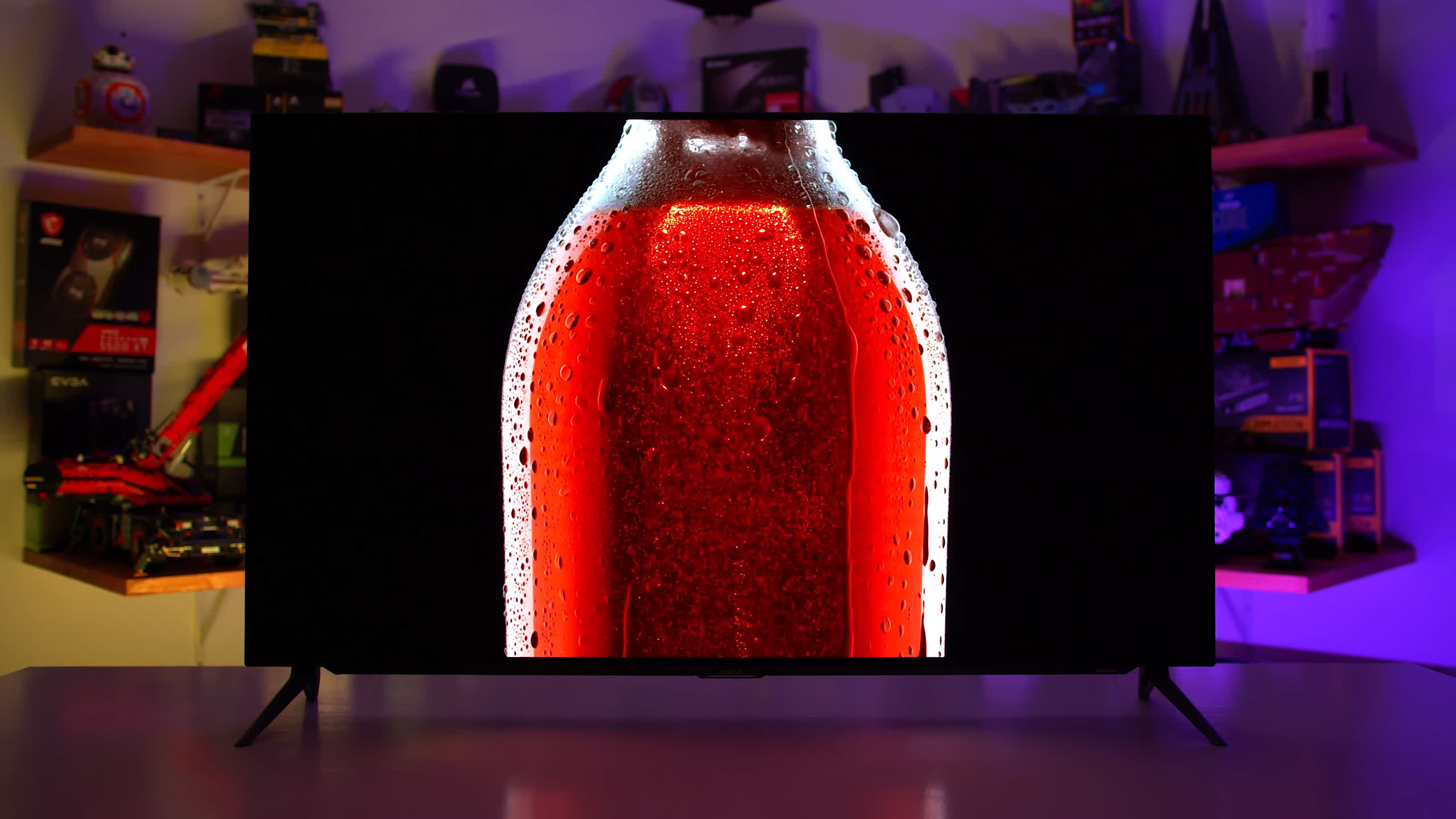Today we're checking out the Aorus FO48U, the latest OLED monitor from Gigabyte... or should we say TV?
It's 48 inches in size, which hardly counts as a normal monitor, but is also a tad small for a modern TV. Another way to describe this, it's just a big gaming display with a 4K resolution, 120Hz refresh rate and OLED technology for that sweet, sweet HDR goodness.
The Aorus FO48U is a particularly interesting display because it uses the same panel as the highly regarded LG C1 OLED that we reviewed a few months back. We looked at how the LG C1 performed as a computer monitor and while that's not its ideal use case, it's a very impressive content consumption display that's great for gaming. The FO48U offers an alternative to LG's model, with a few more PC specific features.
The big one is the addition of DisplayPort, which makes it more compatible with today's graphics cards. The LG C1 requires HDMI 2.1 for 120Hz operation, so that restricts it to RTX 3000 and RX 6000 series GPUs, as well as current generation consoles.
The Aorus FO48U supporting DisplayPort 1.4 with DSC makes it easier to use with previous-gen GPUs that support that tech, but didn't end up getting HDMI 2.1, like Nvidia's RTX 20 series.
Gigabyte also offers KVM switch functionality, allowing you to use a single keyboard and mouse with multiple input devices, a neat addition that's becoming standard across the company's lineup. The OSD is actually very similar to other Gigabyte monitors, so other features like their dashboard and cheat crosshairs are also there.
With Gigabyte taking a bigger focus on monitor functionality with their 48-inch OLED, this means there are no TV features at all. The LG C1 comes with a full set smart TV options and app support, interesting image processing features like AI upscaling and noise reduction, and a TV tuner. The FO48U has none of that – some might prefer not to have any internet connected features on their TV and just want it to be a dumb display, but there's no doubting the feature list suffers as a result.
The FO48U also takes a backwards step on HDMI inputs. Yes, we do get DisplayPort, but there's just two HDMI 2.1 ports instead of four on the LG C1, and the HDMI 2.1 ports are limited to just 24 Gbps. This means to achieve 120Hz at 4K it needs DSC over HDMI, which causes limits for some devices like the PlayStation 5. That's a bit of a fail, not to offer the full 48Gbps unfortunately.
Design and Features
It terms of how it looks, this is very much a TV, with zero ergonomic adjustment possible as the display is held up by two short, fixed leg stands. The build quality is good overall, with an expansive glass panel on the front, metal legs, and reasonable use of plastic and metal on the rear.
Like the LG, the top section of the display is very thin to highlight the thinness of OLED, though this balloons out in the middle and bottom to fit in the components. The inputs are all located on the left side of the display.
Running along the bottom is a speaker array, which looks fine and are the basic sort of TV speakers you usually expect to receive (and should probably only be a backup audio source). There is a directional toggle for controlling the OSD along the bottom edge, and Gigabyte also includes a basic IR remote (that looks a lot like a Fire TV remote) if you're using the FO48U more like a TV.
Before getting into the performance section of the review, it's important to bring up some of the things we talked about in our LG C1 review on what it's like to use a 48-inch OLED as a monitor. This is huge monitor and it does require a large desk. The FO48U is 25 cm wider than a 34-inch ultrawide at 107 cm wide, and 68 cm tall, so at normal desk viewing distances it seems massive and might be larger than your field of view. You'll want to sit back further than normal to use it. I'd recommend at least a 1 meter/3 feet viewing distance, whereas for other monitors 60 to 70 cm is more appropriate.
Pixel density is the same as you get on a 32-inch 1440p monitor, which is fine and gives you a lot of screen real estate. However the RGBW pixel layout does affect text clarity for desktop use. At 100% resolution scaling it's not as sharp as a standard RGB panel (like a normal IPS monitor), even after a run through Windows' ClearType utility. This display is not designed for fine-text rendering in desktop applications but it's more of a content consumption monitor.
The panel uses a glossy finish with an anti-reflection coating, which does deliver increased clarity and a "wow" factor that you only get with glossy finishes. I think this generally looks great in darker environments, but in rooms with a lot of back lighting, the coating is less effective than the more matte anti-glare coating you get on other monitors.
The Aorus FO48U is much more likely to reproduce clear, defined, mirror-like reflections rather than the less obvious diffuse reflections from anti-glare monitors. LG's anti-reflection coating used with their OLED panels is one of the best as far as cutting down on the possible reflections from a glossy finish, but it still wasn't enough to fully alleviate the issue in my brightly lit office, especially with the lower brightness of an OLED display.
There's also the serious risk of permanent burn-in with an OLED panel, especially if you plan on using this display as a desktop monitor where there will be lots of static content. Linus recently did a video explaining his experience with an OLED as a desktop productivity monitor where he experienced burn-in rather quickly, so I would be cautious of using the FO48U that way. Linus did present what I feel is a worst case scenario for OLEDs and his specific use case was highly at risk for burn-in – more so than with typical usage – but there's no doubt that OLEDs are at risk while LCD monitors are not.
The Aorus FO48U doesn't have quite as many burn in protection features as the LG C1. The C1 has automatic logo dimming and pixel shifting capabilities. Now, pixel shifting isn't great for desktop use, but it's not included at all on the Gigabyte model.
Gigabyte does implement automatic dimming after periods of inactivity, eventually culminating in a built-in screensaver after 15 minutes, though this only applies when the content on screen doesn't change at all. This is handy when you're away from your PC, but won't necessarily save it for actual use with static desktop apps. On a positive note, Gigabyte does include automatic pixel refreshers like the LG.
While this all might sound a bit scary, my personal experience using OLEDs over the last few years – my main TV is an LG OLED – suggests that burn-in is unlikely if you're using the display for content consumption and gaming, even after several years. My TV has no burn-in even though I watch a lot of sports on it with static logos. This is generally what other people have experienced, too, with the latest panels. However I would recommend against buying the FO48U for heavy all-day desktop productivity usage, a bit of desktop use mixed in with gaming and video playback isn't going to be a big issue, but lots of static content is an issue and something to be mindful of.
Display Performance
In terms of response time performance, because the FO48U is an OLED panel, it's extremely fast and doesn't require overdrive settings. The automatic brightness limiter did make it a bit more difficult than usual to gather these numbers but we found a suitable workaround that's very accurate, which was basically to make the test window small.
As such what you'll see here at 120Hz are results very similar to the LG C1 OLED, in that the average response time is around 1.5ms using our strict test methodology, with zero appreciable overshoot, and ludicrously good cumulative deviation of below 100, which indicates near instant response behaviour.
This behavior is held at lower refresh rates, so whether you're running the display at a fixed 120Hz, fixed 60Hz, or with adaptive sync variable refresh rates, performance is always excellent and so the monitor has a single overdrive mode experience. Well... it would have one anyway as there's no overdrive modes, but you know what I mean, performance is great across the refresh range and fantastic for PC gaming.

Compared to other monitors, the FO48U destroys LCD panels under the best conditions. Performance is very similar to the LG C1 so you're not missing out there at all, while overall response times are several times better than even the best LCD monitors. The motion clarity as a result is unparalleled and this is one of the major reasons to get an OLED instead of an LCD.

It gets better looking at average performance across the refresh range, where the FO48U is even further ahead of the LCD pack. Not only is overshoot completely negligible on average, response times are outstanding, so at any refresh rate you can be sure motion performance is as good as you can get.

But it's not just about response times, cumulative deviation is also important to getting an idea how fast the FO48U and OLED panels are. These displays aren't just fast, but they are fast over the vast majority of the transition with very little lingering delay at either end. This leads to exceptionally good cumulative deviation, as the transition behavior is very close to the ideal instant square-edge response. LCD panels are laughable in comparison as seen in the huge delta between them and the top of the table OLEDs.


120Hz performance is excellent either for PC gaming or use with current generation consoles. No other display I've tested comes close to the motion performance on offer here at the same refresh rate. It's similar at 60Hz, though response behavior is limited by the refresh rate itself, which causes motion blur inherently with a sample and hold display. However this is clearly as good as it gets from modern displays at 60Hz.

Input lag is a non issue with the FO48U, coming in at under 1ms of processing delay, and a total delay in the chain equivalent to 240Hz monitors due to its extremely fast transition times. This means that while the FO48U doesn't feel as smooth as a 240Hz monitor as you are only seeing half the amount of refreshes, the actual delay to getting the image into your eyeballs is just as fast. However the FO48U has no inherent delay advantage over the LG C1, which in its PC configuration also has very low input lag, so removing all those TV features hasn't given Gigabyte any leg up.

Power consumption is very high, typically double that of an LCD due to its size. And that's at a lower brightness level as well, as the FO48U can't actually hit 200 nits for a full screen white window that we test with for power consumption. It's actually dimmer than the LG C1 as we'll show later in this review, which causes the discrepancy between the Gigabyte and LG models. But basically OLED is not as efficient of a technology as LCD for displaying bright images, so power consumption is high.
The FO48U does support backlight strobing, or in this case black frame insertion as the OLED panel doesn't technically have a backlight. Unfortunately it doesn't work with adaptive sync simultaneously; the Aim Stabilizer feature is only accessible at fixed refresh rates, though both 120Hz and 60Hz operation is supported.
While the 120Hz mode is very similar visually to the LG C1's OLED Motion Pro feature, in that it delivers perfect strobing with an extremely clear image, there's an issue with the 60Hz implementation. At 60Hz, it looks like the FO48U is double strobing which causes two images on the screen at the same time. This is ugly and looks bad, so the LG variant has the superior backlight strobing implementation as it's actually usable at 60Hz.
Color Performance
Color Space: Gigabyte Aorus FO48U - D65-P3
Color performance is generally very good from the FO48U and other OLEDs based on LG's panels. The display is wide gamut and optimized for P3, with a very high 97% coverage of that gamut in our testing. However it's not as wide as the best LCD panels of today, which offer full Adobe RGB coverage as well. The FO48U covers less than 90% of Adobe RGB, leading to a total Rec. 2020 coverage of 70% - that's a good result, but not the best I've seen, though still sufficient for HDR use.
Default Color Performance
One of the main issues with the LG C1 was terrible out of the box calibration, particularly for greyscale. That's less of an issue with the Gigabyte model. The default mode isn't perfect and both the gamma and color temperature charts are a little wonky for sRGB usage, leading to only mid-range deltaEs – but this is miles better than how the C1 comes configured.


Unfortunately while the C1 defaults to an sRGB color space for SDR usage, the FO48U does not, so colors are oversaturated out of the box, even with the color space mode set to "auto". This is more in line with typical monitor performance, though it's not accurate and the way the LG OLED handles things is better. This isn't the end of the world but when you check performance up against other displays the FO48U is only mid table in both of our tests, in fact greyscale performance could probably do with more optimization.
With that said, the FO48U does come with an sRGB mode, which improves performance significantly. Greyscale performance is more accurate to the sRGB gamma curve, although it did adjust color temperature negatively and this can't be changed – once again it's dumb that some displays don't allow white point adjustment in their sRGB mode. However it does effectively clamp the gamut so overall deltaE performance is pretty good and this mode in general is very usable for regular SDR content.
Calibrated Color Performance
When it comes to calibrating the FO48U, this display acts mostly like a monitor, so it really lacks the advanced calibration features of the LG C1. The C1 gives you much greater control over white point and greyscale adjustment, and you can tweak all sorts of values straight in the hardware, so you don't need to rely on ICC profiles. In fact you can even use special paid software like Calman for LG to enhance the calibration further. None of this is available with the FO48U, so its calibration options are much weaker.
You can achieve great results with a calibration pass in Portrait Display's Calman software, but we're talking about a pure software solution that relies on ICC profiles and app compatibility. So while the results are decent, the FO48U suffers from less robust hardware calibration support.

Peak brightness from a full white window is awful, and remains the major issue with OLED technology and why I wouldn't recommend using this display for desktop usage. Not only is the FO48U dimmer than the C1 for full white images – which affects desktop apps – it also has a more aggressive automatic brightness limiter. The ABL feature means that the FO48U increases display brightness when the content on the screen has a lower average picture level, in other words, if there's more black or dark areas on the screen, the brighter white areas will become. This is most noticeable when resizing app windows on the desktop, if you make a bright browser window larger, brightness will drop, and vice versa.
There also appears to be no way to get around this. On the LG C1, you could either make the display even dimmer, which tended to stop the ABL from activating, or use the service menu to disable the feature in some firmware versions. The FO48U's ABL is always active and more noticeable in use. I don't think this is a big deal for content consumption as it's not that visible in videos or games, but when using this display as a desktop monitor it's annoying.
Minimum brightness is unbelievable though, this is not a joke, when the brightness level is set to 0, the display tops out at 1 nit. I'm not sure how useful that is in practice, but that's very dim.

Contrast is infinite with the FO48U as the OLED panel is self lit, so each individual pixel has the capability to fully switch off to display black. This is far superior to any LCD monitor I've tested, and black levels are even darker than the best VA LCD panels. The glossy panel helps accentuate this in most viewing environments, leading to spectacular visuals. It's also one reason why OLEDs can get away with lower peak brightness for content consumption, as the deep blacks still produce a high contrast experience that your eye can adjust nicely to.
Viewing angles are superb and I find the FO48U and other OLEDs to be highly viewable even at crazy angles. Uniformity was also very solid with my unit. At times OLEDs can be a bit iffy with uniformity but my FO48U was actually better than my C1 in this regard leading to strong results.
One of the big selling points to buying an OLED like this is the HDR experience. The FO48U offers a true HDR presentation, hitting all major criteria, including the big one in contrast. As I've been talking about, self-lit panels are capable of incredible contrast ratios, which is the entire benefit to HDR and why OLED is especially well suited to HDR – at least in contrast to most of today's LCD monitors.
In real world HDR content, whether that's games or videos, the FO48U has no blooming like you would see with an LCD with full array local dimming. Bright and dark areas can peacefully coexist on the screen simultaneously with no crossover, leading to absolutely stunning HDR visuals. Combined with deep blacks and a lot of depth to shadow detail, I think the FO48U looks great in most HDR content.


But the one area where this display suffers is once again in brightness. OLEDs do compensate for this to some degree by their zero black levels, but a full screen white image topping out at 123 nits can only take you so far. This pales in comparison to the best LCD monitors of today. There's also really no capacity for this display to produce a bright full screen flash for something like an explosion, which is disappointing.

The main issue with the FO48U's HDR performance is small window brightness. The LG C1 does pretty well here, reaching 775 nits which means that bright highlights on the screen are genuinely quite bright. The FO48U doesn't fare nearly as well in its default HDR mode, only reaching 555 nits. Yeah this is better than SDR performance, but it's hardly impressive and well behind the C1 that uses the same panel.
The FO48U does include an "HDR Vivid" mode which increases brightness in the same test and gets closer to what the C1 can do, but it completely destroys accuracy. Darker tones are too bright in this mode, and the white point is strongly tinted blue, so it seems this mode is trying to cheat a high brightness level for the sake of testing. We haven't used this mode in our charts for that reason as it doesn't look good in practice. In real world usage the FO48U is dimmer than the LG C1 and that's just the reality of it.
Brightness vs window size is a little better for the FO48U, which performs similarly to the C1 down to a window size of 25%, and eventually closes the gap at smaller window sizes like 2%. Fundamentally though, HDR brightness is on the weaker end of the scale and while I still think it looks great for HDR in general, it's not as great as the LG C1.
Obviously the main advantage here though is the contrast ratio. While LCDs top out at around 12000:1 in our worst case single frame contrast tests, OLEDs are still capable of infinite contrast so they look far better and don't suffer from blooming issues.
HDR accuracy is acceptable, the FO48U is a little bright when displaying darker tones and the aggressive roll-off can hurt the level of detail in bright scenes as the roll-off point is quite early in the EOTF curve. But overall it's not too bad. Then for color tracking, results are okay as well, this display isn't unnecessarily oversaturating colors in the HDR mode which is a good thing for the visual presentation.
Hot or Not?
Overall, the Gigabyte Aorus FO48U is one of those displays where if you had it in isolation and you didn't compare it to many other products, we think you'd be very happy with it. There is no doubting it looks excellent when displaying content, whether that's movies or games in either its HDR or SDR modes, and that's all down to the use of OLED.
Blacks are deep, contrast is infinite, and response times are lightning fast, to the point where it embarrasses LCD panels in motion clarity.
Unfortunately for Gigabyte though, the Aorus FO48U isn't as good as LG's C1 OLED that we reviewed earlier. Despite both using essentially the same LG OLED panel or a close variation of it, the C1 has more features with better performance in some key areas. On the flip side, Gigabyte don't have many unique features of their own that are worth caring about.
While the FO48U is essentially the same as the C1 in areas like response times, contrast and color gamut, the C1 is noticeably brighter in HDR content, to the tune of 100-200 nits brighter. That's a big deal on an OLED panel where brightness is less than amazing. And sure, both panels have poor full screen white brightness that makes desktop use less than stellar, but in the HDR mode the C1 looks better.
The LG C1 also has a less aggressive auto-brightness limiter, though both panels are still annoying in how brightness changes depending on the content.
The LG C1 is a far more feature rich display. It comes with four full bandwidth HDMI 2.1 ports (versus two 24 Gbps ports on the Gigabyte), it has a full array of TV functionality including smart TV apps, a TV tuner, AI upscaling, denoising and more. It supports Dolby Vision where the FO48U only supports HDR10 and HLG. It has a much better range of hardware calibration features. It has a better black frame insertion mode. And then on top of that, it's got a decent set of features to make it compatible with PCs and gaming setups, including a low latency mode, allowing it to match other gaming monitors.
The Aorus FO48U counters that with a DisplayPort connector, a KVM switch, and some gaming-specific OSD features. That's not anywhere near enough to make up for the big list of omissions. For example, we'd rate Dolby Vision support as far more important than having DisplayPort. The reality for Gigabyte is they are competing against a TV giant that has refined their offering for gamers over several iterations now. Thus launching a first-gen OLED offering with key feature omissions isn't going to cut it.
Of course, this can be salvaged with a competitive price point: the Aorus FO48U has to be several hundred dollars cheaper than the LG C1 to make sense. But that's not the case and the actual delta can differ depending on the region. In the US, the MSRP of both products is the same, and often the LG C1 is cheaper due to discounts and promo pricing. In Australia, the retail price is less than the LG model, but the C1 frequently receives discounts to nullify that gap. This makes it hard to recommend the Gigabyte model even though it's far from a poor performer.
